Welcome to what has become a somewhat rare event – another Extreme Rigs review! This time we will be looking at EK’s latest threadripper block. We previously looked at some of EK’s earlier attempts in the Threadripper block roundup from 18 months ago. EK missed out on a top spot in that roundup due to a poor TIM spread and they weren’t the only ones that had that issue. One thing I love about EK is how they constantly release new products to such an extent that I sometimes I wonder if they have more new products a year than the other companies combined. So it’s almost no surprise when another new version of their threadripper block showed up before I’d even finished testing the previous version.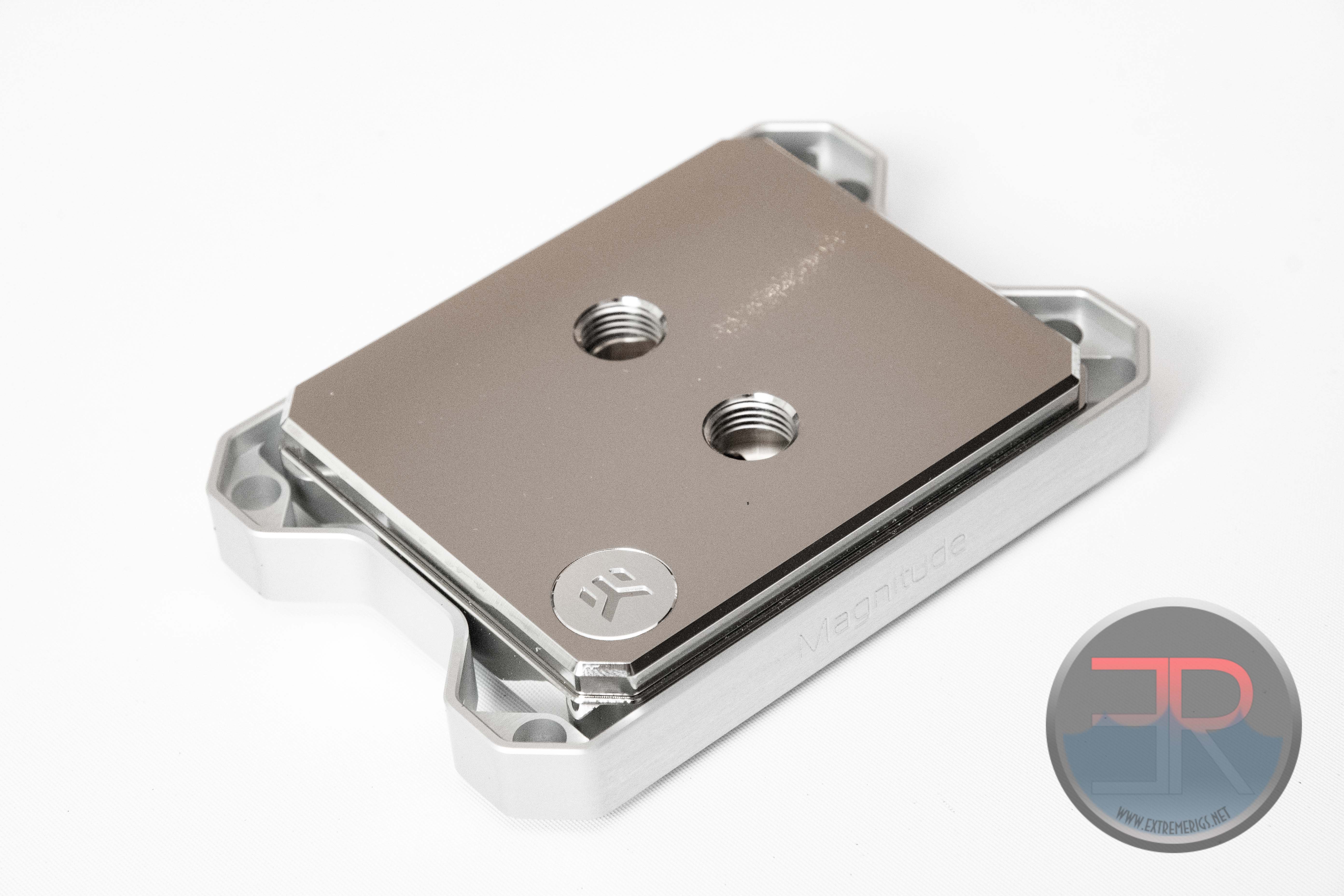 So this is where we are today – AMD has released 3 generations of threadripper and EK are now on their 5th generation of the water block. Given all of these versions then we are expecting some top notch performance to beat the winner from our previous round up – the Watercool Heatkiller IV. So before we dig too much into the latest version – let’s recap on EK’s evolution of their threadripper blocks
So this is where we are today – AMD has released 3 generations of threadripper and EK are now on their 5th generation of the water block. Given all of these versions then we are expecting some top notch performance to beat the winner from our previous round up – the Watercool Heatkiller IV. So before we dig too much into the latest version – let’s recap on EK’s evolution of their threadripper blocks
V1 – Supremacy EVO with original cooling core with baseplate extended to cover IHS (not reviewed):
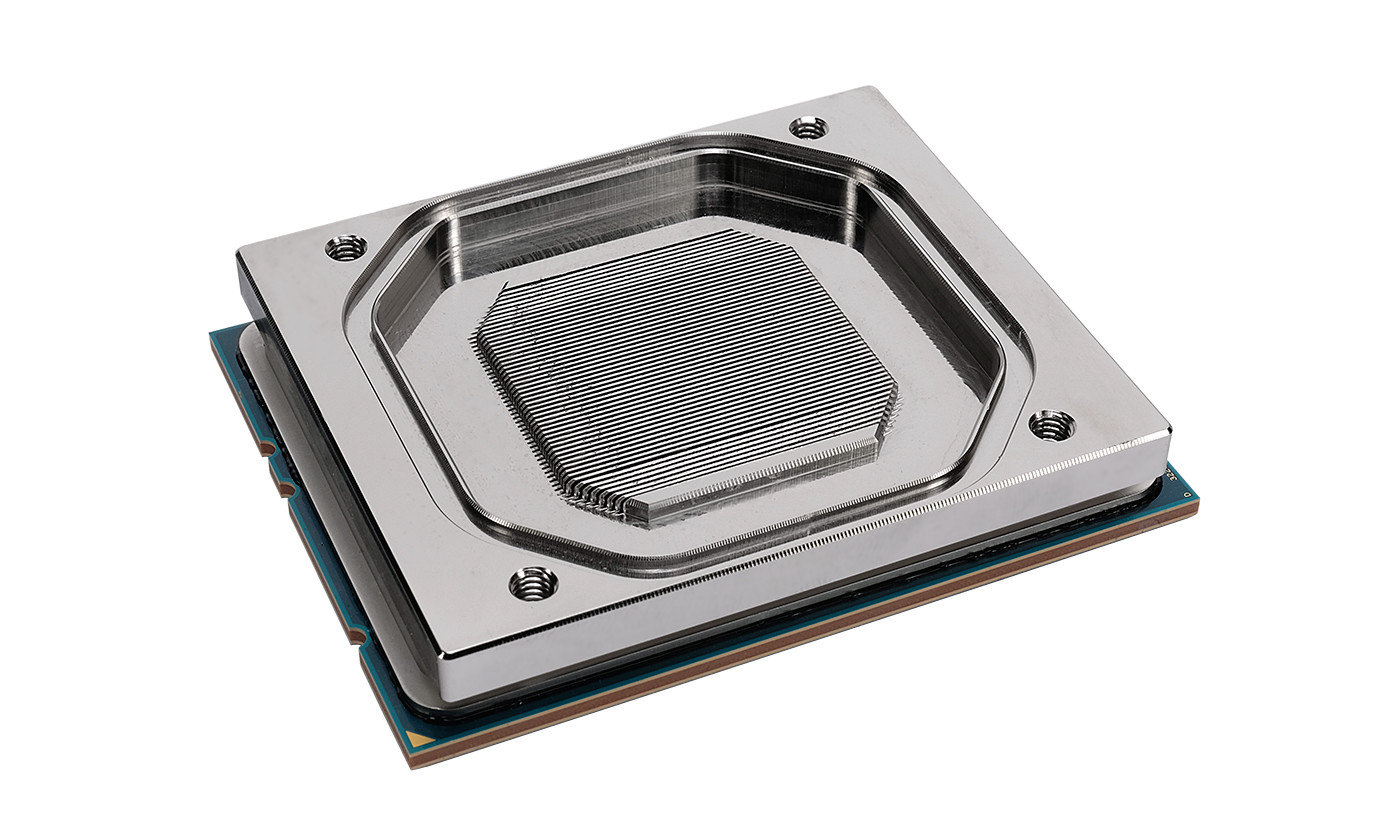
V2 – Supremacy EVO with larger cooling core covering full IHS but a single jetplate (not reviewed):
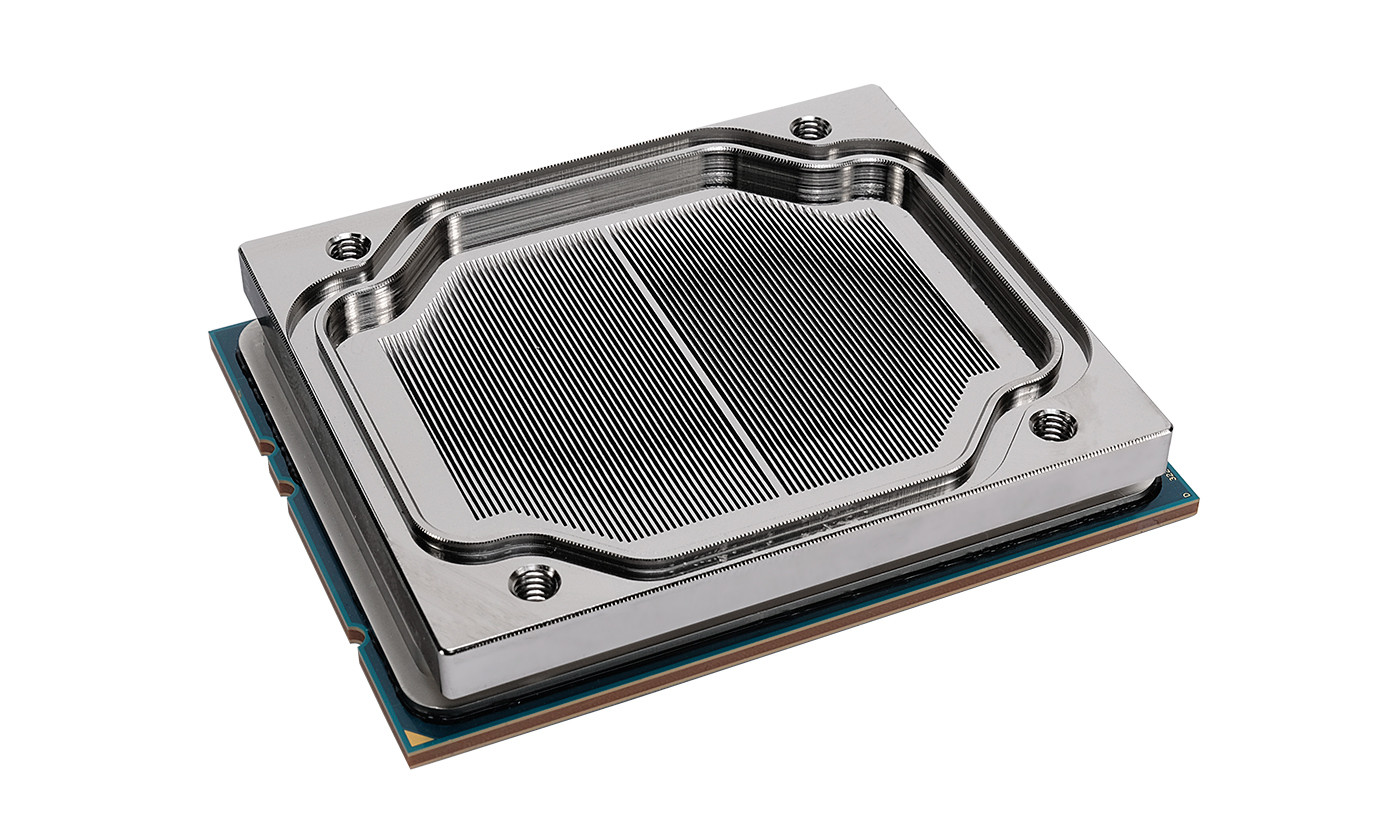
V3 – Supremacy sTR4 with re-optimized cooling core and a double jetplate but poor tim spread (reviewed previously):
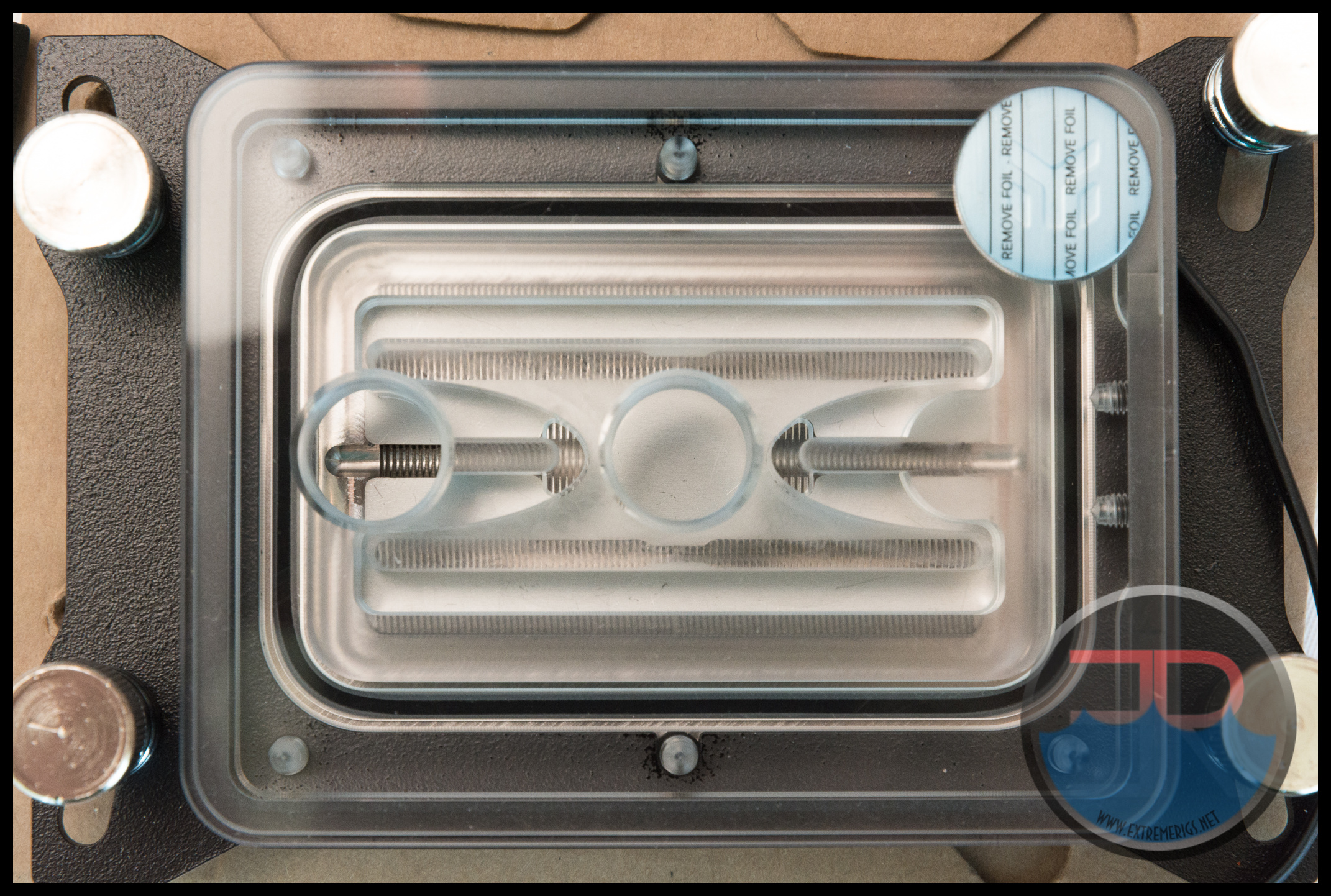
V4 – Quantum Velocity sTR4 – updated cooling core that is larger with finer channels and a better but imperfect tim spread and confusingly EK also went back to a more basic single jetplate:
V5 – Quantum Magnitude sTRX4 (this review) – another cooling core update, improved tim spread and a complex double jetplate/insert, note also that the channel orientation has changed again.
I actually really appreciate that EK keep iterating and trying to improve performance. Some of the iterations however do confuse me – why did V4 go back to a single jetplate for example? Why does the channel orientation flip multiple times? What happened to thumb screws? I get the sense that different designers worked on each version, and perhaps some of those designers were better than others or simply had less time to polish the design. As I didn’t get to finish the Quantum Velocity review before the Magnitude then let’s unbox the two side by side:
The packaging for both is a similar style, and as usual EK’s packaging is top notch in style. It’s packaging that will stand out and you won’t get the impression that they cut corners. What is really noticeable though is the difference in box size. While the Threadripper is a big CPU, the new magnitude box is massive. One thing I don’t like is that the box has a picture of the Intel block on the front, it’s not a huge deal, and obviously saves costs but intrinsically it annoys me.
The larger magnitude box has space for more languages but otherwise isn’t vastly different beyond the size. In order to check it’s the Threadripper block you need to look at the label on the base.
EK’s internal double box is the same as normal:
The Magnitude is surrounded by foam while the Velocity is placed on cardboard:
Sometimes we would see that the cardboard didn’t hold the block well and that the plastic bag would get torn. Interestingly the Magnitude no longer gets a plastic bag.
The new packaging feels pretty indestructible. The Magnitude has a separate bag containing the mount unlike the Velocity which has an integrated mount. Personally I like an integrated mount, but in reality unless you are a reviewer you don’t mount the block very many times. I also like that EK include TIM, while you may want to buy your own fancy stuff, it’s always nice to have in case you run out or to practice a mount with and check the spread.
The mount on the Velocity uses tool-less thumb screws that are shown in the pictures above – some people like this, while others value their skin and prefer a tool. They worked adequately for me. The magnitude on the other hand was a little fiddley because the pieces to mount it were quite small:
Honestly though mounting it was no big deal and only annoying if you had to do it very many times.
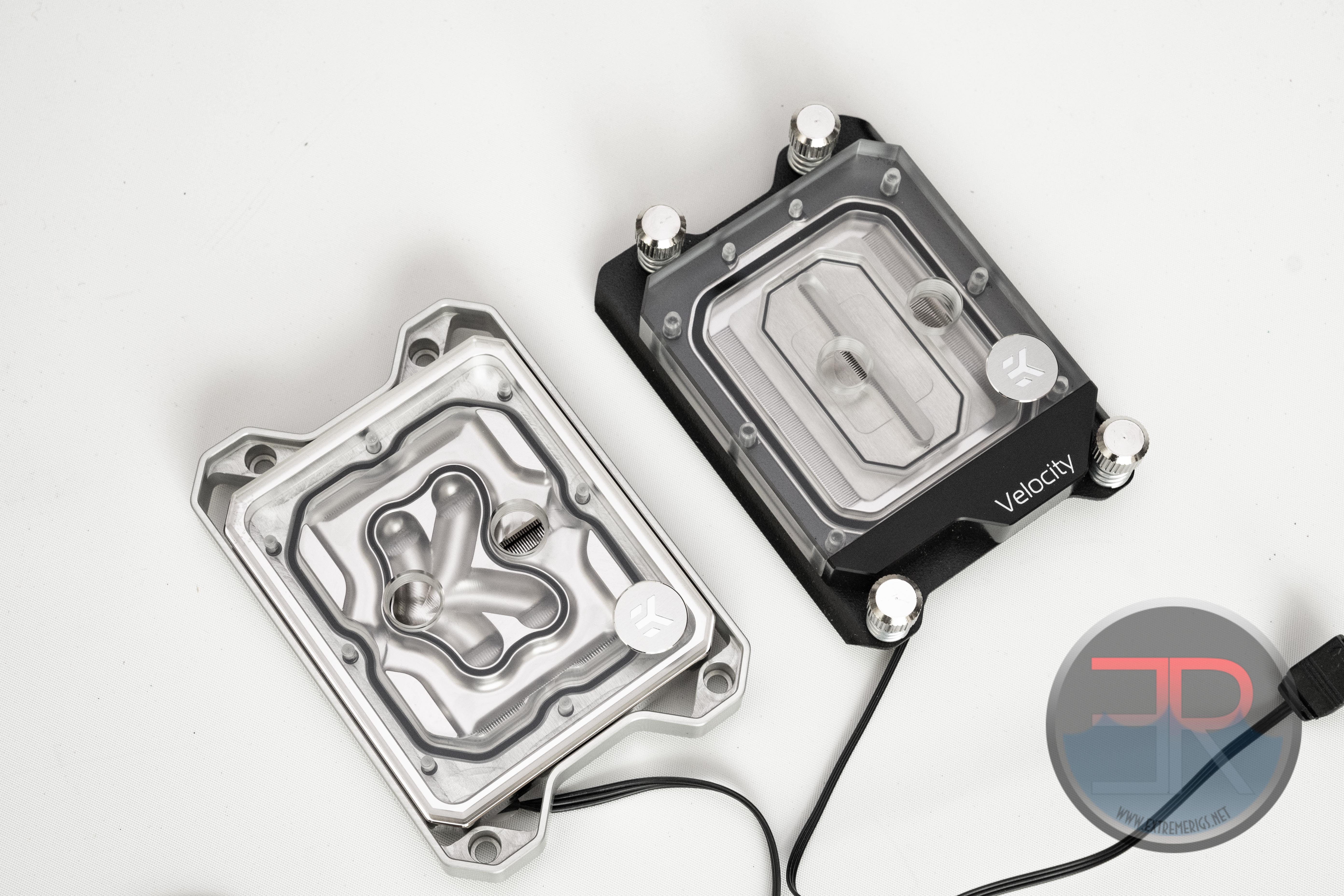 Side by side we can see that the Magnitude is a larger more complex block that maximizes the potential cooling area. The Velocity on the other seems relatively simple and “old school in it’s engineering. Aesthetically though the Velocity is a nice design. The magnitude as an aluminum tray that mismatches to the internal nickel plating.
Side by side we can see that the Magnitude is a larger more complex block that maximizes the potential cooling area. The Velocity on the other seems relatively simple and “old school in it’s engineering. Aesthetically though the Velocity is a nice design. The magnitude as an aluminum tray that mismatches to the internal nickel plating.
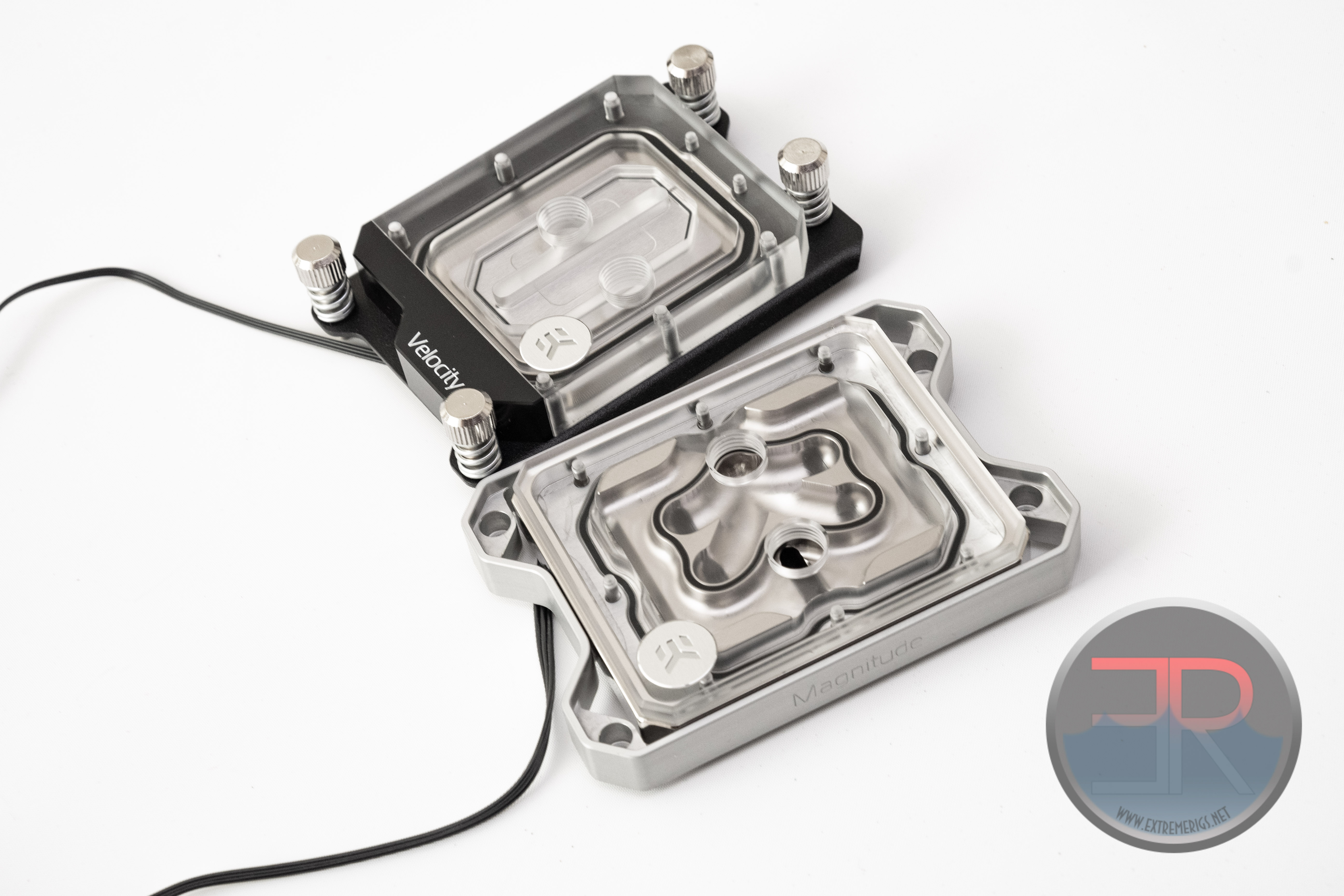 The Magnitude relegates it’s branding to one side of the bracket – it’s understated vs the white on black text of the Velocity block.
The Magnitude relegates it’s branding to one side of the bracket – it’s understated vs the white on black text of the Velocity block.
Overall both blocks look good, it’s kind of like whether you prefer coffee or tea. To further complicate things there are also the full metal versions:
The Magnitude with it’s cleaner lines I think works better for the full metal block. One other difference for the eagle eyed is that the full metal Velocity includes built in LEDs while the full metal Magnitude does not. Both plexi versions however have LEDs. The other difference is in the LED header – the Velocity has a four pin RGB header, while the Magnitude has the same header but with one pin blanked out to avoid it being accidentally plugged into the wrong header. FWIW here’s a shot of the Plexi Magnitude lit up:
The full metal blocks have become increasingly heavy. The lightest block is the plexi topped Velocity at 420g:
The Magnitude Plexi on the other hand increase the weight by 100g without even including the mount that was built into the Velocity, presumably the stiff aluminum plate and the complex and large metal insert are to blame:
The full metal magnitude on the other hand is a monster clocking in at nearly 1Kg:
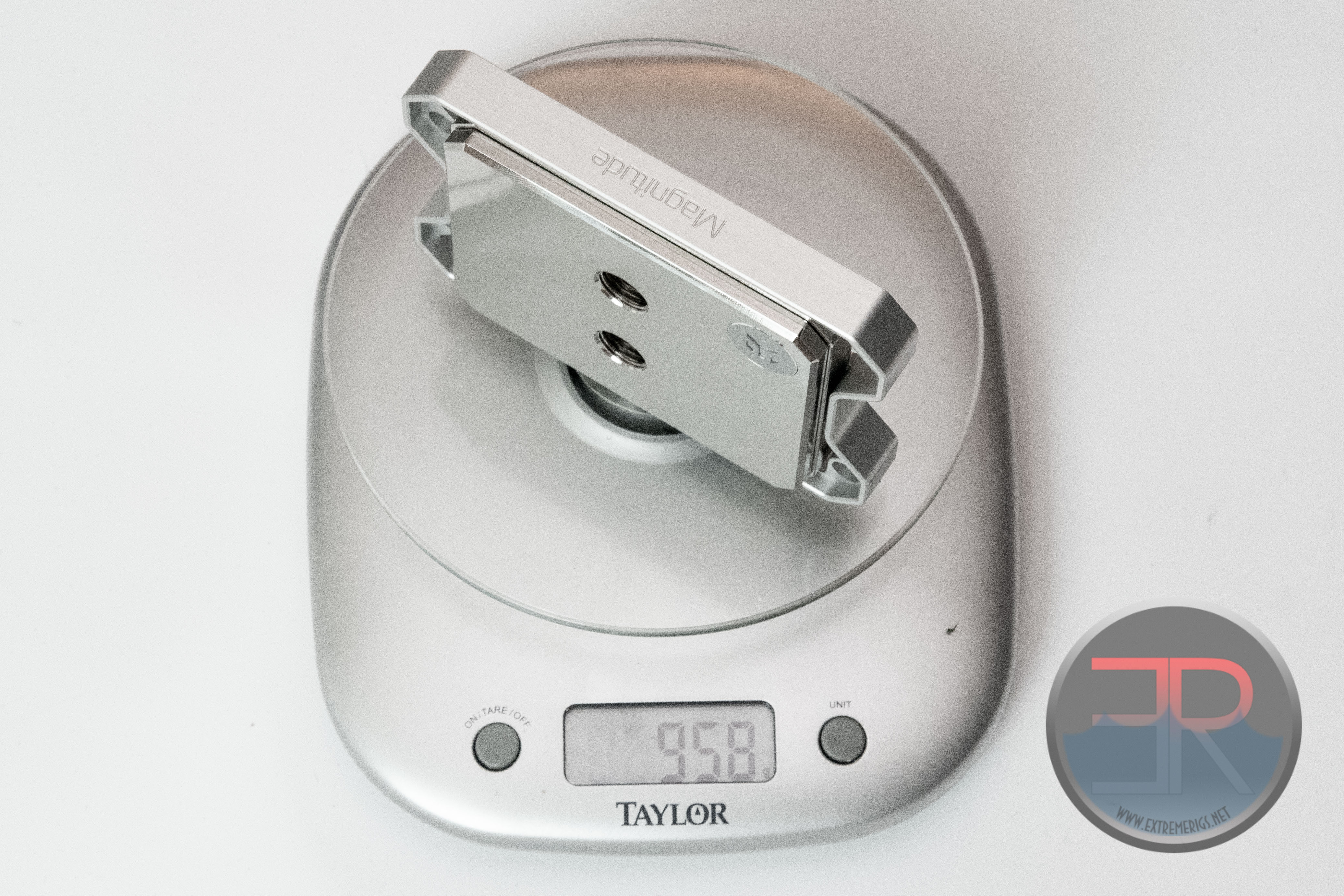 If you are considering the full metal block you may want to consider the mounting of your motherboard and if it’s going to be stiff enough to not bend under this weight.
If you are considering the full metal block you may want to consider the mounting of your motherboard and if it’s going to be stiff enough to not bend under this weight.
Both Velocity and Magnitude blocks come with the same base protector stickers from prior versions – these work great:
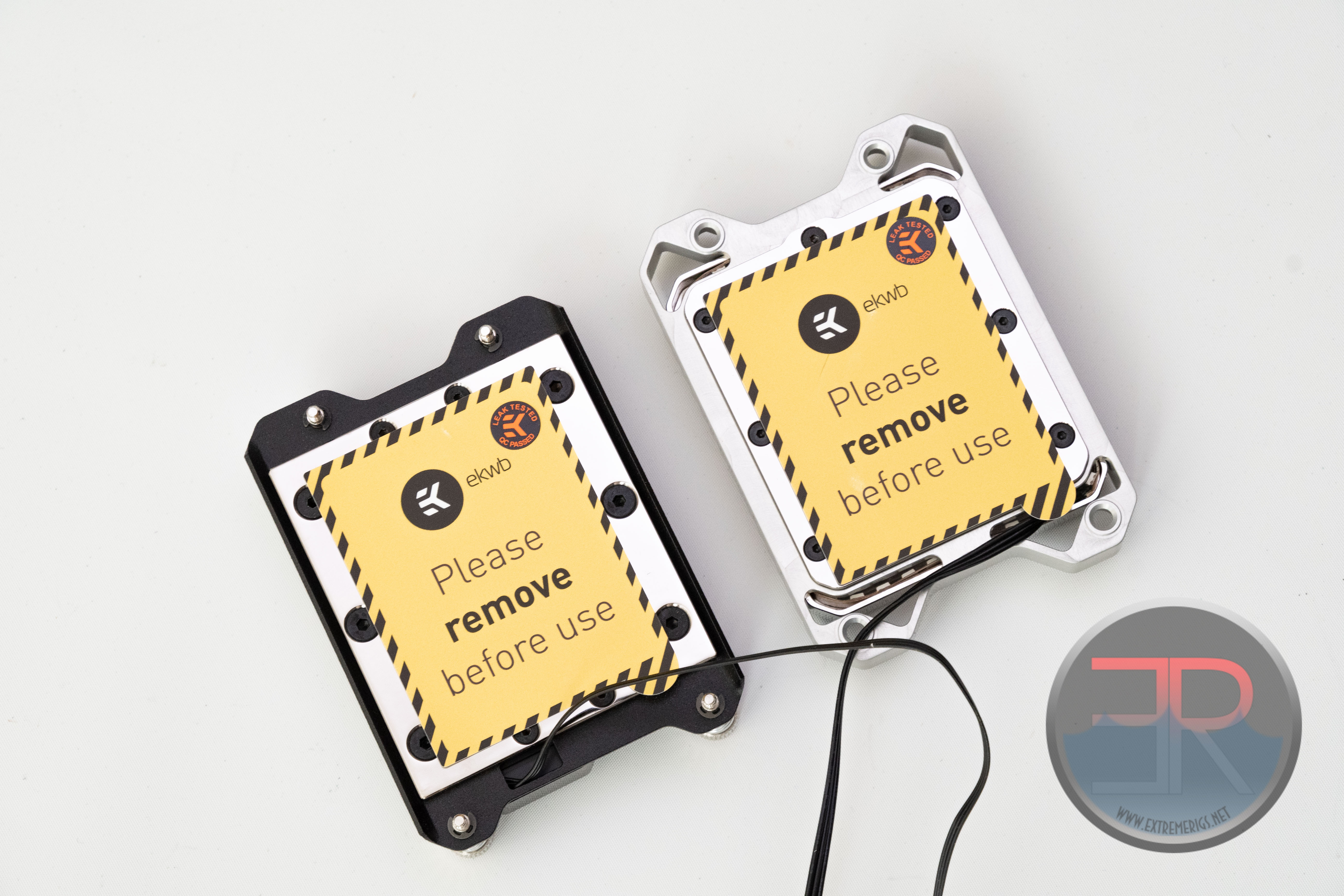 We love that the stickers are obvious and not see through plastic as some other manufacturers have used in the past. Removing the stickers however shows a significant difference in the machining of the base. EK have always given us a well polished base for a very long time now:
We love that the stickers are obvious and not see through plastic as some other manufacturers have used in the past. Removing the stickers however shows a significant difference in the machining of the base. EK have always given us a well polished base for a very long time now:
The Velocity continues that, but the Magnitude instead is left with a rougher finish that has been machined.
Let’s take a look at the internals of the Quantum Magnitude block. We disassembled the Full Nickel block after all testing was complete. The 8 screws are removed with a standard allen key – note that this is not the same as the included allen key that is used for mounting the block. Also note that the base is keyed to make sure you don’t insert it upside down:
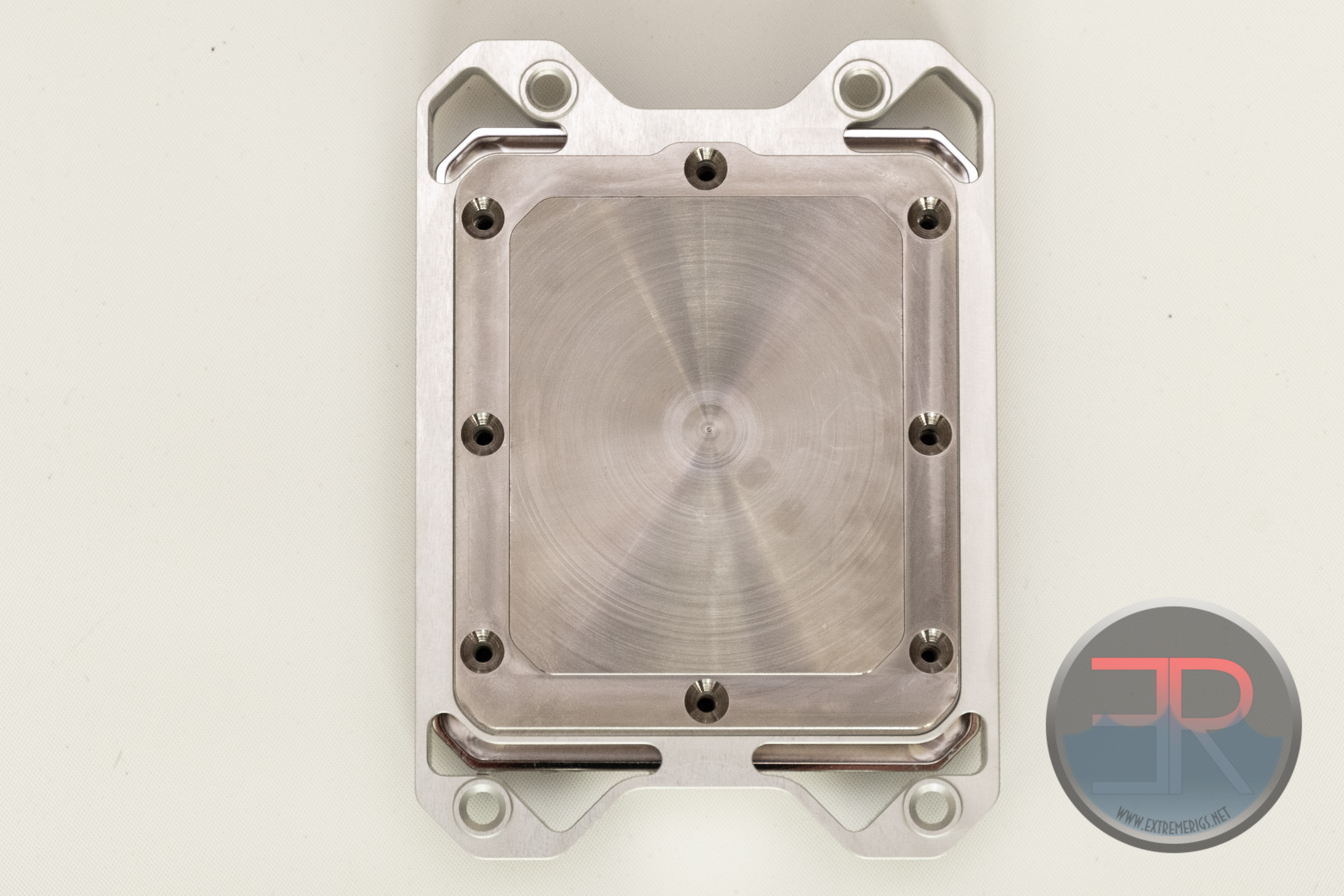 Removing the base shows a brass insert and two metal stainless steel jetplates:
Removing the base shows a brass insert and two metal stainless steel jetplates: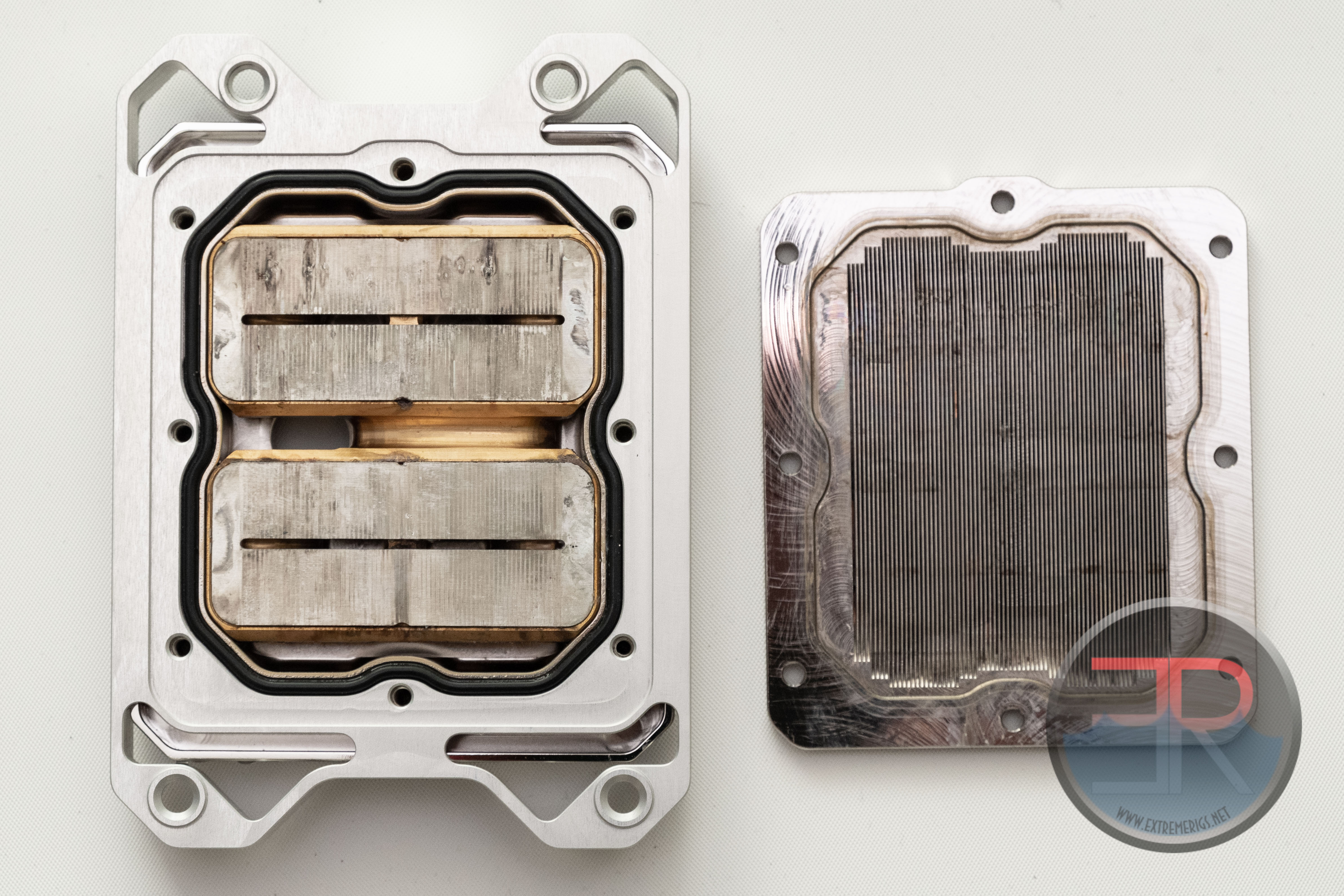 Removing all the pieces shows the full stackup:
Removing all the pieces shows the full stackup: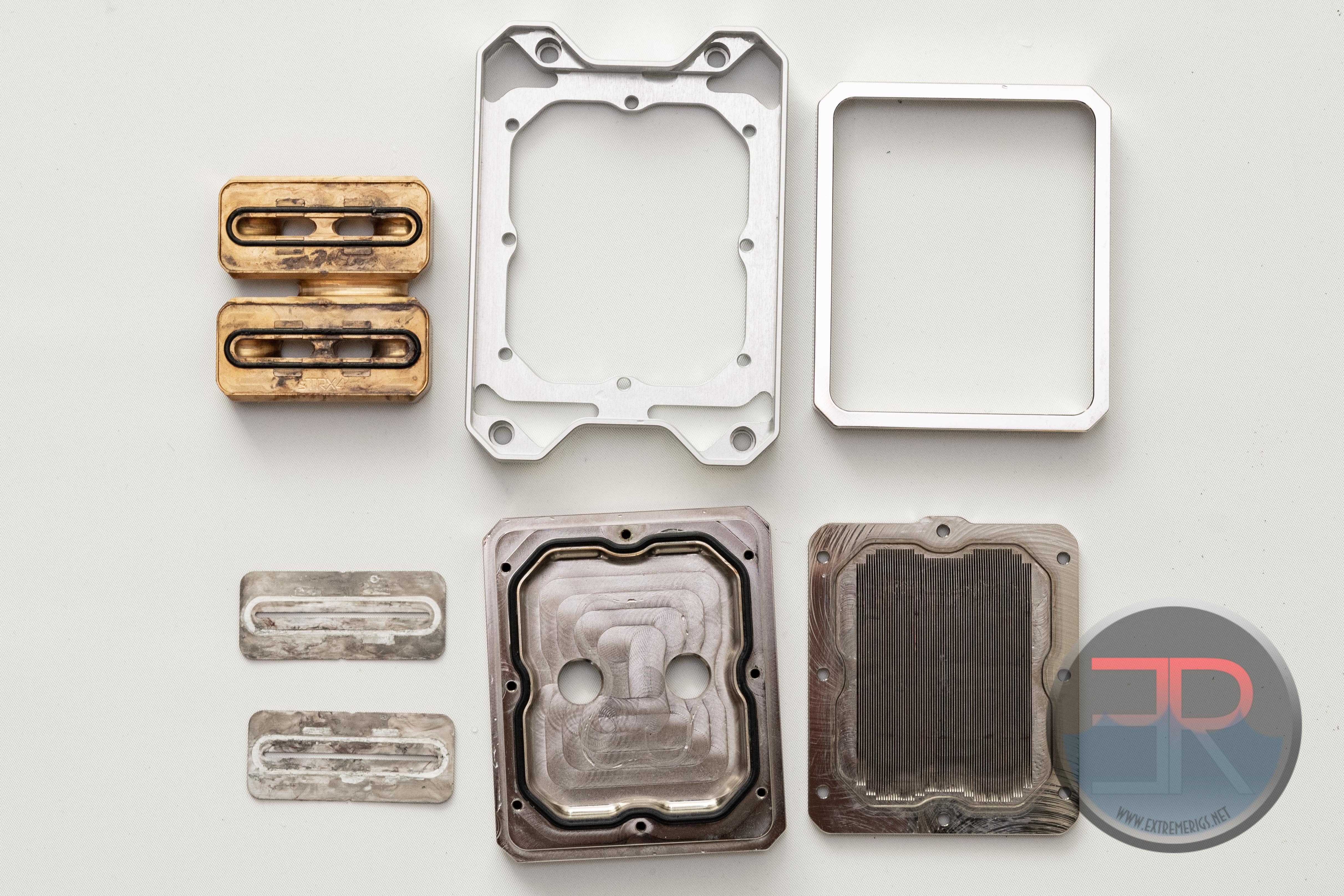 Interestingly the brass insert can be put in two different ways which can lead to a different port being selected as the input port. This piece is not keyed unlike the nickel plated copper top and bottom. This is a nice feature as it’s not uncommon for a user to feel forced to run a CPU block “backwards” so as to make the loop construction easier or more aesthetic. Running a block backwards typically only affects temps by 1-2C, but it’s nice to to give up hard earned performance.
Interestingly the brass insert can be put in two different ways which can lead to a different port being selected as the input port. This piece is not keyed unlike the nickel plated copper top and bottom. This is a nice feature as it’s not uncommon for a user to feel forced to run a CPU block “backwards” so as to make the loop construction easier or more aesthetic. Running a block backwards typically only affects temps by 1-2C, but it’s nice to to give up hard earned performance.
On the plexi version the brass insert is nickel plated. While the full nickel version here has an unplated brass insert, I believe only the acetal copper version of the block will have an unplated brass insert. In addition the top right chromed piece is what is used to house the LED’s in the plexi version I believe. There are different colors and options for this which will be available for another $30 to customize your block more. All in all we have quite a few different metals here – nickel plate copper, unplated brass and stainless steel that all may make contact as well as contact the water. The aluminum mounting plate however does not make contact with the water however and therefore should resist corrosion due to the larger electropotential difference.
Testing
At some point when testing the V4 version (Quantum Velocity) my 1950x CPU died, and a replacement 1950x measured much lower temperatures across the board leading me to suspect there was something unusual about that first CPU. Perhaps there was a manufacturing problem with my original 1950x and while the new 1950x performance was judged more representative I decided to abandon 1950x testing and move to a 2nd generation threadripper – a 2950x. While I wanted to upgrade to the latest generation threadripper I could not justify the funds for the cheapest 24 core model. As I upgraded the cpu I also decided to upgrade other key parts of the system including a new motherboard (Asus ROG Zenith Extreme) and also more RAM (16 -> 64GB) at a faster speed (2800 ->3200). While the 2950x isn’t as fast as the latest threadrippers it should still model them well thermally. Due to restarting the testing we can’t compare apples to apples from earlier data, therefore I also retested the winning block from the 1950x round of testing. However if the new EK blocks beats the Heatkiller block on the 2950x setup we can assume it also beats all the previous blocks from the last test on the 1950x.
TIM Spread
The thermal interface material aka TIM is a critical component in water cooling results. This is because the water blocks are now so good at cooling that the thermal connection between the CPU’s IHS and the water block’s base can be a major factor in the performance. A good tim spread leads to a thin uniform layer of TIM on top of the entire IHS. For example – one reason I believe the Heatkiller IV block did so well was it’s excellent TIM spread. It had a very even and thin spread over the entire CPU IHS.
Any uncovered area on the IHS also usually leads to worse performance, however too much TIM may lead to an unnecessarily thick layer of TIM that the mount pressure can’t squeeze out. A good tim spread is therefore helped by using enough mount pressure Mount pressure is usually limited by the specifications of the board or socket – however we do suspect some manufactures exceed (or allow the user to exceed) this specification and it’s too hard for us to actually check whether this is the case. Having said all of this mount pressure is usually not the major determining factor behind a poor or good mount – instead it’s more about how well the shape of the block mates with the shape of the CPU IHS.
Typically the CPU IHS is not flat and neither is the water block. Most manufacturers put a slight bow on the water block so as to make sure the center of the water block has the best contact with the CPU’s IHS. This works particularly well for CPU’s with a centrally located die – however Threadripper consists of four CPU dies mounted in the four quadrants. It’s worth noting that the water block’s bow is often created by the use of a central jetplate or insert creating stress between the halfs of the waterblock. This is interesting in the case of manufacturer’s who offer both plastic and metal tops for the blocks. Many people think the performance differences of metal vs plastic topped water blocks is due to the metal offering more surface area to cool the coolant – however it’s surface area is too small to really do much and depends heavily on the surrounding airflow and temperature – essentially it’s a horrible radiator. Instead the performance difference is because the metal top is stiffer than the plastic top and transfers a greater proportion of the bow to the base. This means sometimes the metal top is better, and sometimes it’s worse. Typically I suspect manufactures optimize their testing with the plastic top for cost reasons, and so I typically expect to see better performance with the plastic top. Due to time we didn’t finish testing both versions of the block, but we will continue to run tests and provide the data at a later point. So let’s take a look at the TIM spreads – let’s start with V4 aka the Quantum Velocity:
The TIM spread here is good only in a small narrow strip across the middle of the block. The block is bowed in one axis only and isn’t optimized to cover the areas where the dies are below the IHS. We expect this block to not do as well as it could and instead be limited by the insulation of this thick TIM.
The Quantum Magnitude (aka V5) on the other hand presents a much improved TIM spread that covers almost the entire IHS. We expect this block to perform better than the previous generation as a result:
The TIM spread almost looks like the thinnest sections correspond to to the four dies themselves. This might however be a trick of the imagination our brain’s delight in seeing patterns.
The TIM spread does not cover as much of the IHS as the Heatkiller, however it seems like it may be thinner in the precise areas where the die is. We expect good performance from such a spread.
Thermal Results
Now that we are prebiased to expect certain thermal results let’s take a look at the actual thermal testing. The setup is similar to last time when we tested on the 1950x. We measure the CPU temperatures as reported by HWInfo and subtract the 27C fudge factor that AMD adds for air coolers. That temperature is measured relative to the coolant temperature measured at the CPU inlet port. So the coolant temp is then subtracted from the cpu temp to present a more accurate portrait of the water block’s performance. Each CPU mount is tested twice by loading the CPU with an all core Prime95 run with custom settings to present a more consistent load- a 30 minute warmup is allowed before data is averaged for an hour. Each block is mounted six times to reduce the effect of luck from tim spread variation on the data. Each mount is repeated twice to reduce errors. This is by far the most thorough data collection we see from any review websites.
Let’s start off with the average results:
As can be seen the new Magnitude block significantly outperforms the Velocity block presumably due to the improved TIM spread. The Magnitude also outperforms our previous roundup winner – the Watercool Heatkiller. The TIM spread of both blocks is equally good, so we expect the difference in temperatures is due to a better cooling core design by EK. This might be due to EK’s use of a double jet plate ensuring that cold coolant hits where the hot dies are located rather than simply the center of the IHS. Below is the “OLD” data from the previous roundup – where the only block that is the same between both tests is the Watercool Heatkiller:
Note the large difference in the CPU temperature for both Heatkiller blocks between setups. The 1950x that I used for the first roundup must have had a poor thermal connection from die to IHS. Perhaps this also contributed to why so many blocks had issues making contact with the IHS fully.
I also compiled the data statistically to generate “99% confidence intervals”. I like these plots because it also gives you an idea of how much the mount variation moves. Ideally I like a low average thermal result – but all else being close to equal – it might be better to choose a block with less mount variation – after all who’s to say you’ll get a perfect mount:
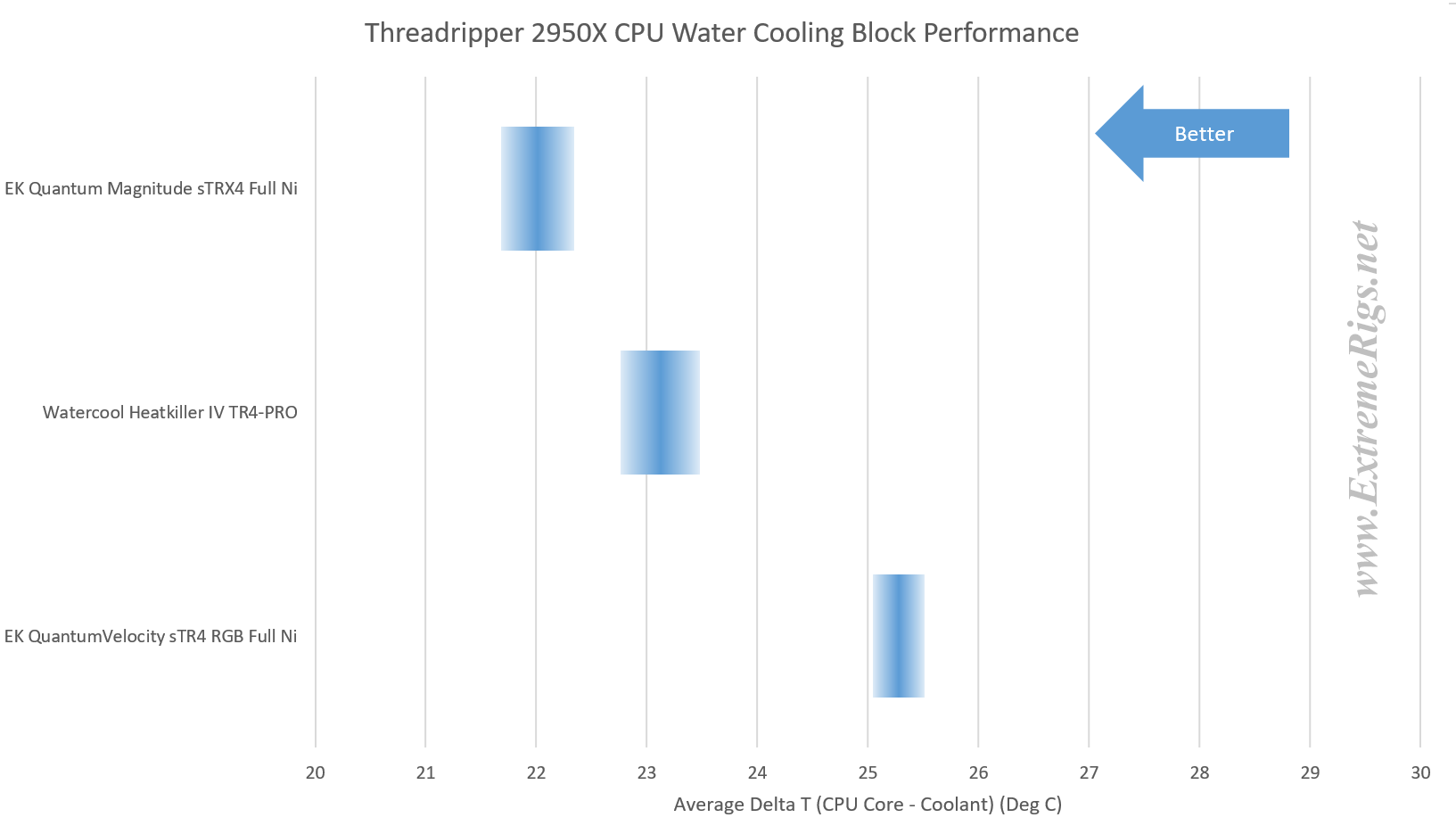 Here we can see that the Magnitude has an acceptable amount of mounting variation and is also statistically significantly better than the Watercool even relative to the measurement error.
Here we can see that the Magnitude has an acceptable amount of mounting variation and is also statistically significantly better than the Watercool even relative to the measurement error.
One other thing we can see is that thermally the Quantum Velocity is not a block to recommend and we suspect that this is due to it’s extreme bow and poor TIM spread. On the other hand the Quantum Magnitude is an excellently designed block with best in class thermal results.
Flow Restriction
The last remaining performance factor is to look at the block’s restriction. While high flow restriction is not a deal breaker it can lower the flow rate in a real system which can lead to lower performance of every component in the loop. If you wish to use high restriction components it’s best to choose a high quality performance pump (or two pumps if you want to run them quietly). For this test we measure the amount of resistance the water block produces in PSI (back pressure) when varying the flow through it (in GPM). I would expect the double jetplate Magnitude design to be approximately half the restriction of the Velocity, however EK’s never designed a high restriction block so even the velocity should be reasonable:
As expected the Velocity is the most restrictive of the three EK versions. Both the V3 – Supremacy sTR4 and the latest V5 – Quantum Magnitude do very well because they both utilize the “double jetplate” theoretically halving the restriction because of that. The Quantum Velocity also used narrow channels in the cooling core that also possibly increase restriction beyond the 2x factor we expect.
Having said this – none of these blocks are close to exceeding our “1PSI @ 1GPM” rule of thumb so they are all perfectly acceptable – not surprising then that our previous award winning Heatkiller block looks like the “worst” in this metic.
Just for completeness – let’s compare all the Threadripper blocks we’ve tested at that 1GPM threshold and sort by restriction:
This really shows you just how low the latest Quantum Magnitude block is in terms of restriction. Typically we’ve seen low restriction blocks take a hit on performance, while sometimes a manufacturer will deliberately choose high restriction to give good performance. There’s usually a tradeoff, but EK have managed to give us top thermal performance and top flow performance simultaneously.
Price
So of course buying a CPU block doesn’t happen in a void. Threadripper CPU’s and motherboards are expensive and if you are buying a top GPU or GPUs as well then your system may easily be $5-15K just in hardware. However as the saying going “20 bucks is 20 bucks” so there is still relative cost between options to consider. The versions of the Quantum Magnitude start at $210 on EK’s store and go up to $270 for a full metal version. As mentioned you may also want to splurge another $30 for a different color accessory plate. When I saw this I had a mini heart attack and wondered if my short break from the water cooling scene had cause me to be out of touch. However after checking in on alternative blocks – like our previous award winner the Watercool Heatkiller IV I found that this was not simply inflation or covid pricing. The watercool block instead retails at a more reasonable $107 to $116 at PPC’s. The Quantum Magnitude blocks are however designed to be a premium product for EK which is why they also maintain the cheaper Velocity blocks for those for whom the price matters. Performance of the EK block might be top notch therefore, but if you focus on performance/dollar then it is not a top performer. Price decisions are however for the readers alone – the Quantum Magnitude absolutely performs better that the Heatkiller – the question is whether that performance is worth the extra money to you?
Conclusion
Recently I’ve felt like we are currently in an era where computer aesthetics often seem to be valued higher than anything else and that the water cooling community has lost it’s focus on solid engineering and performance. Often any water cooling component’s thermal performance is often considered good enough just by existing and so it’s very refreshing that EK have kept on a quest to perfect the engineering of this design. This is not to say EK are perfect. Clearly the early threadripper block designs had weaknesses and the frequent iterations confused me when they weren’t the level that I have come to expect from EK. Often it seemed like EK tackled one issue but in doing so caused another weakness to pop up. However the new Quantum Magnitude puts this era of playing “whack a mole” to bed. The new block has outstanding performance in every area and the only caveat to that is of course the price. Overall I have no hesitation in recommending it as the new best in class Threadripper performance block. Bravo to EK for having the guts and determination to keep improving – it has payed off! Obviously the block gets our highest award.
Where to buy – $210 – $70:
EK Webshop has all the variations here.









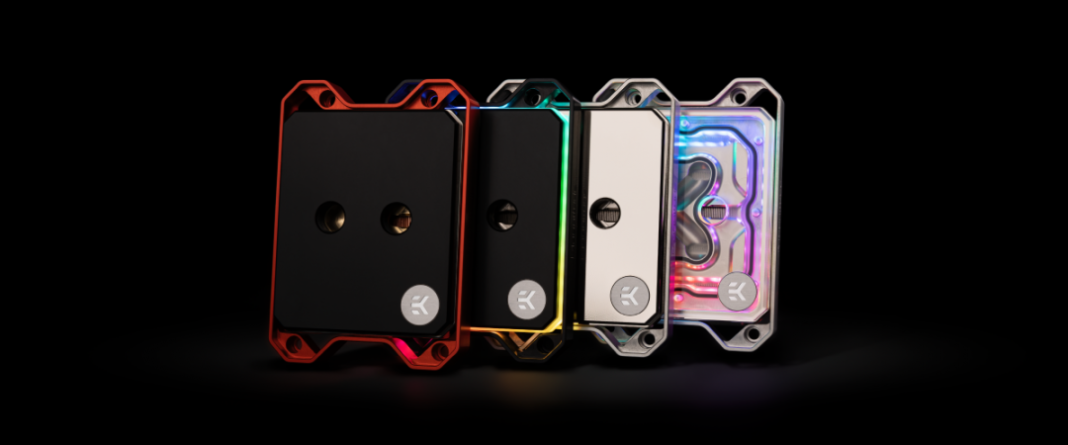
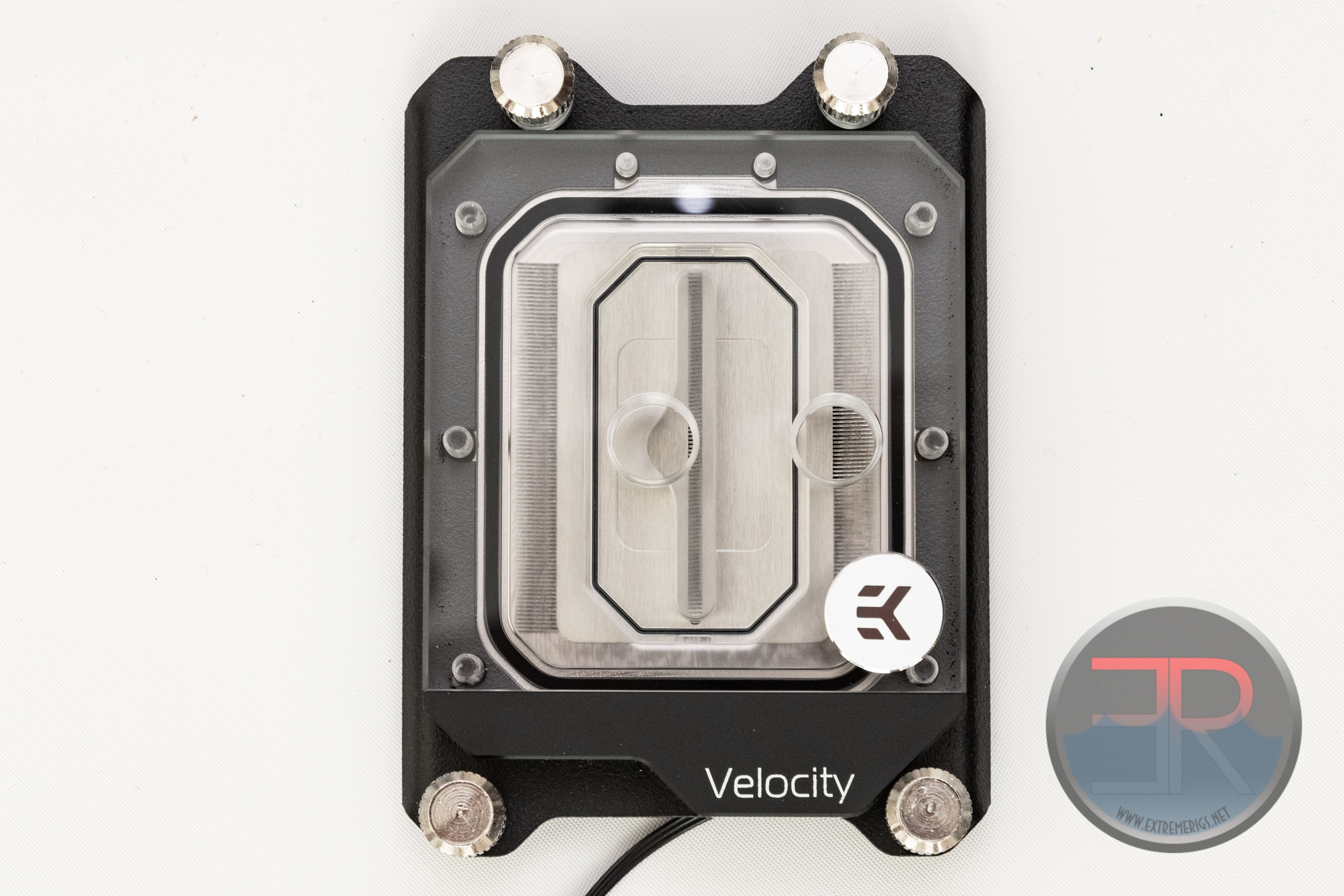
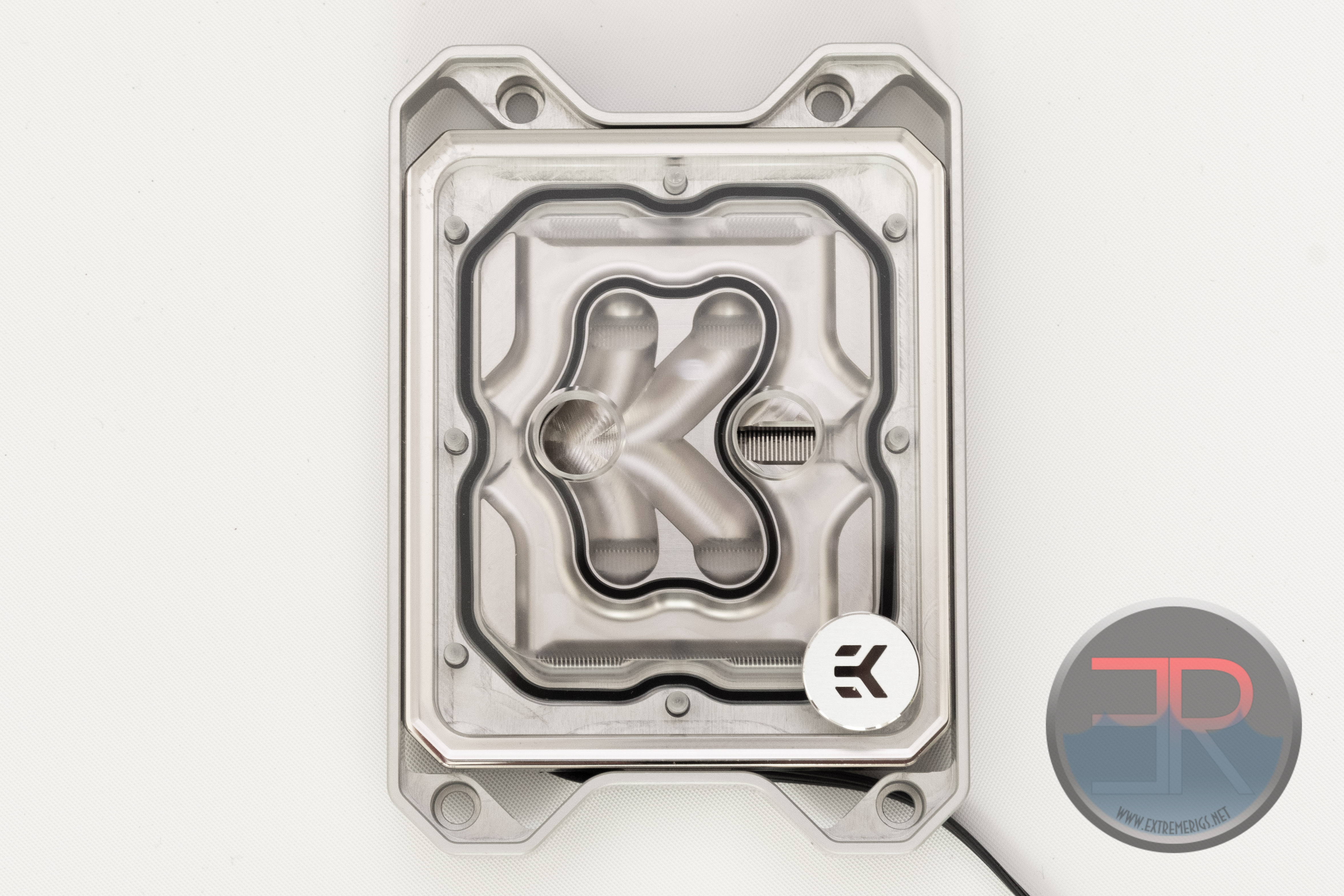
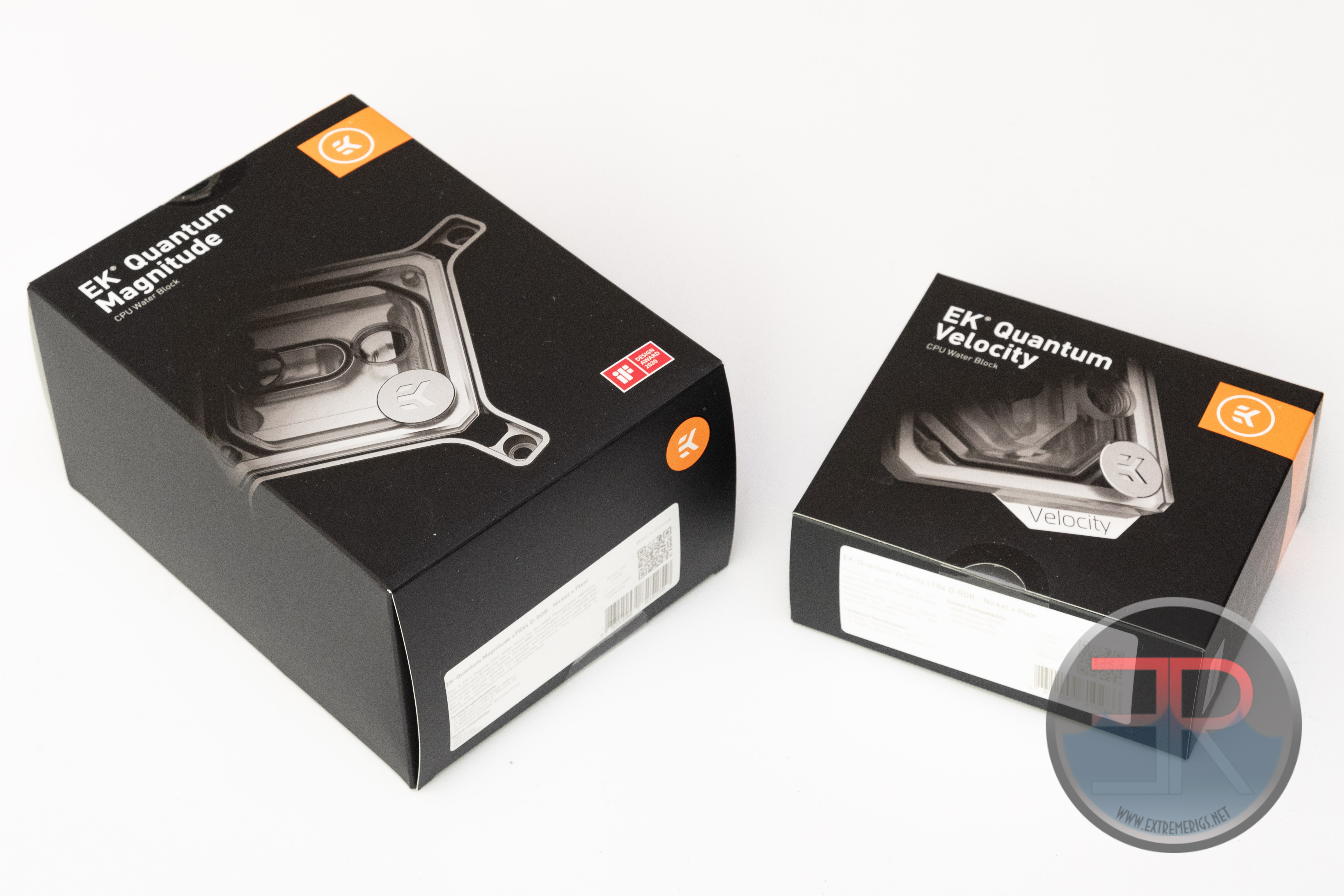
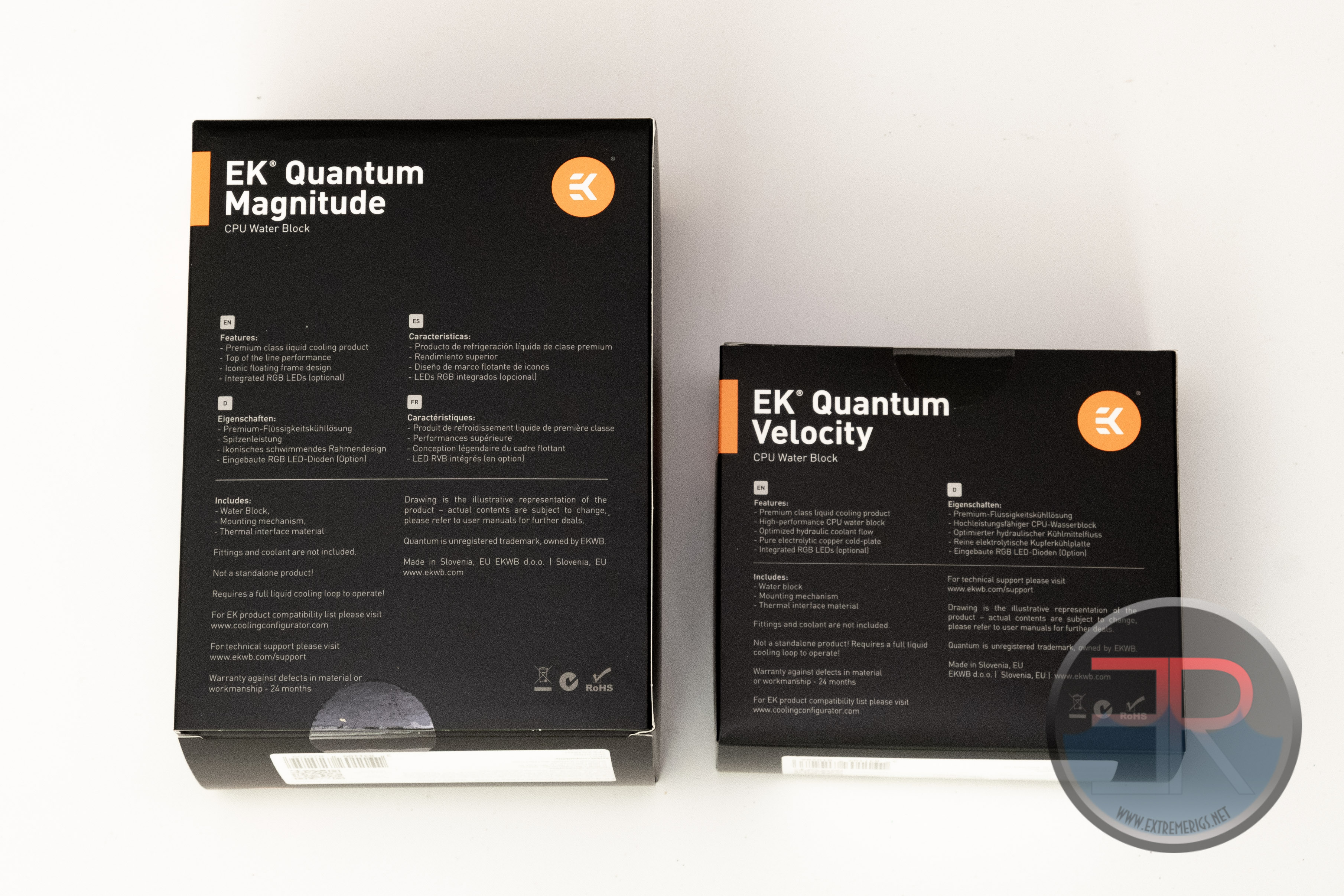
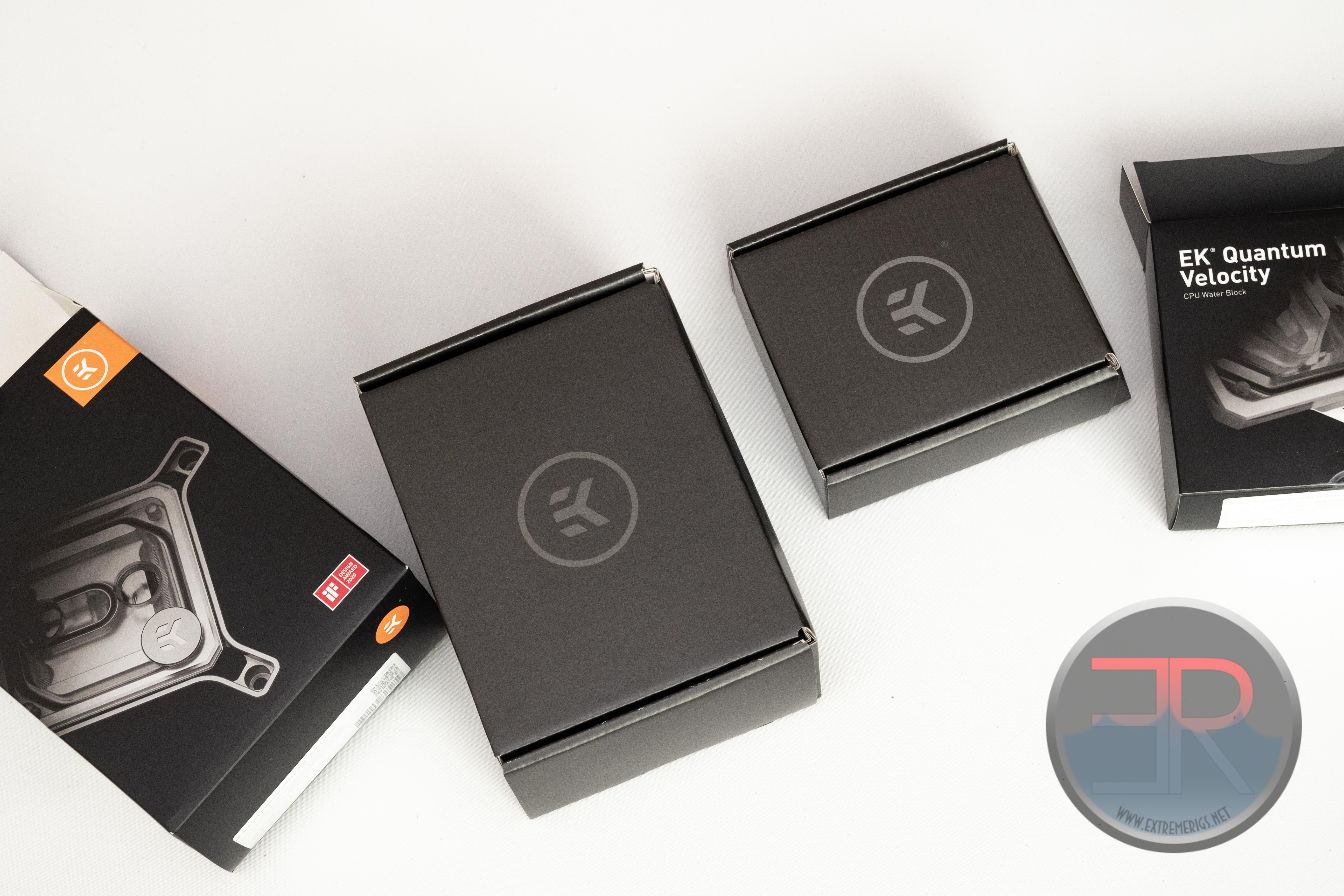
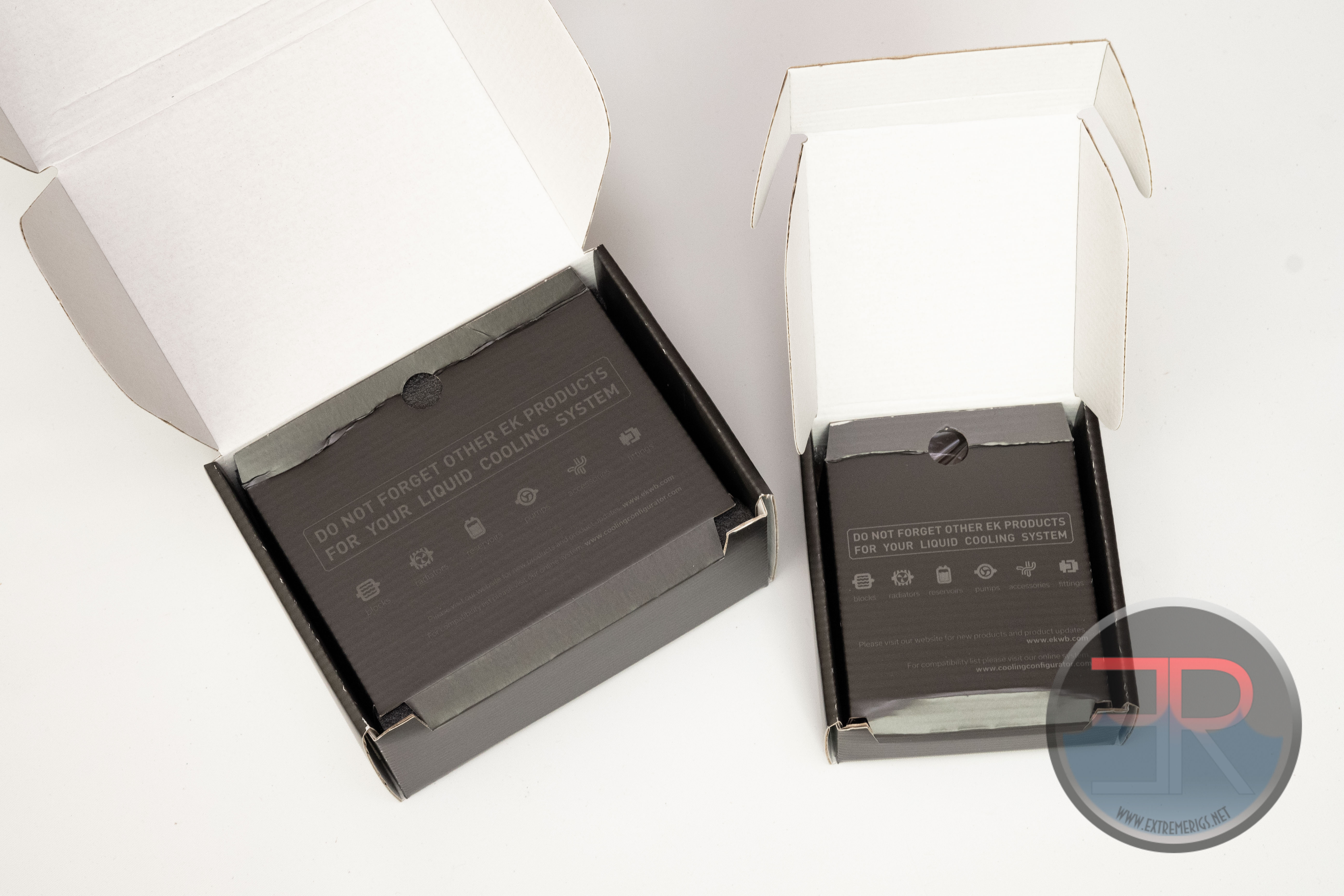
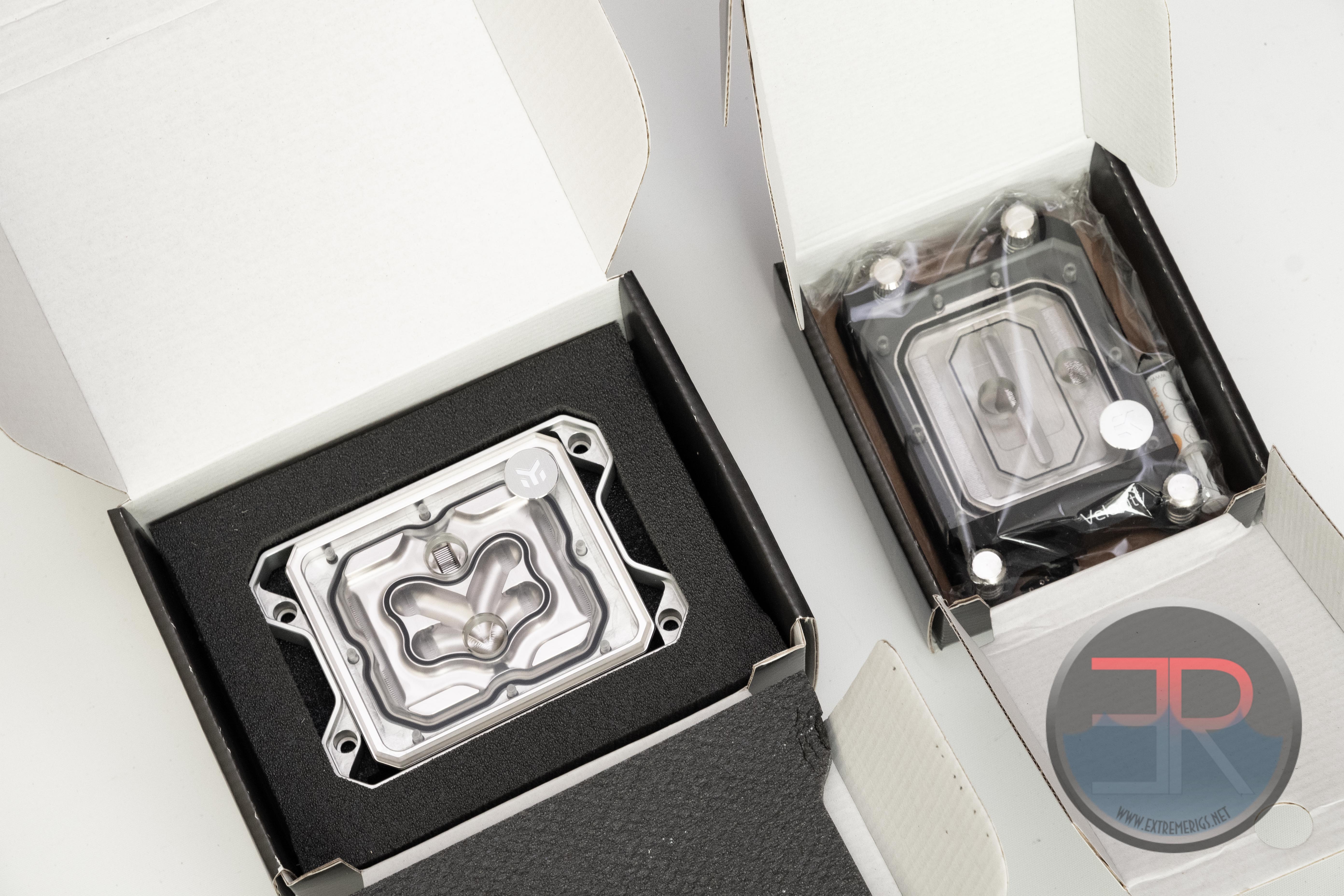
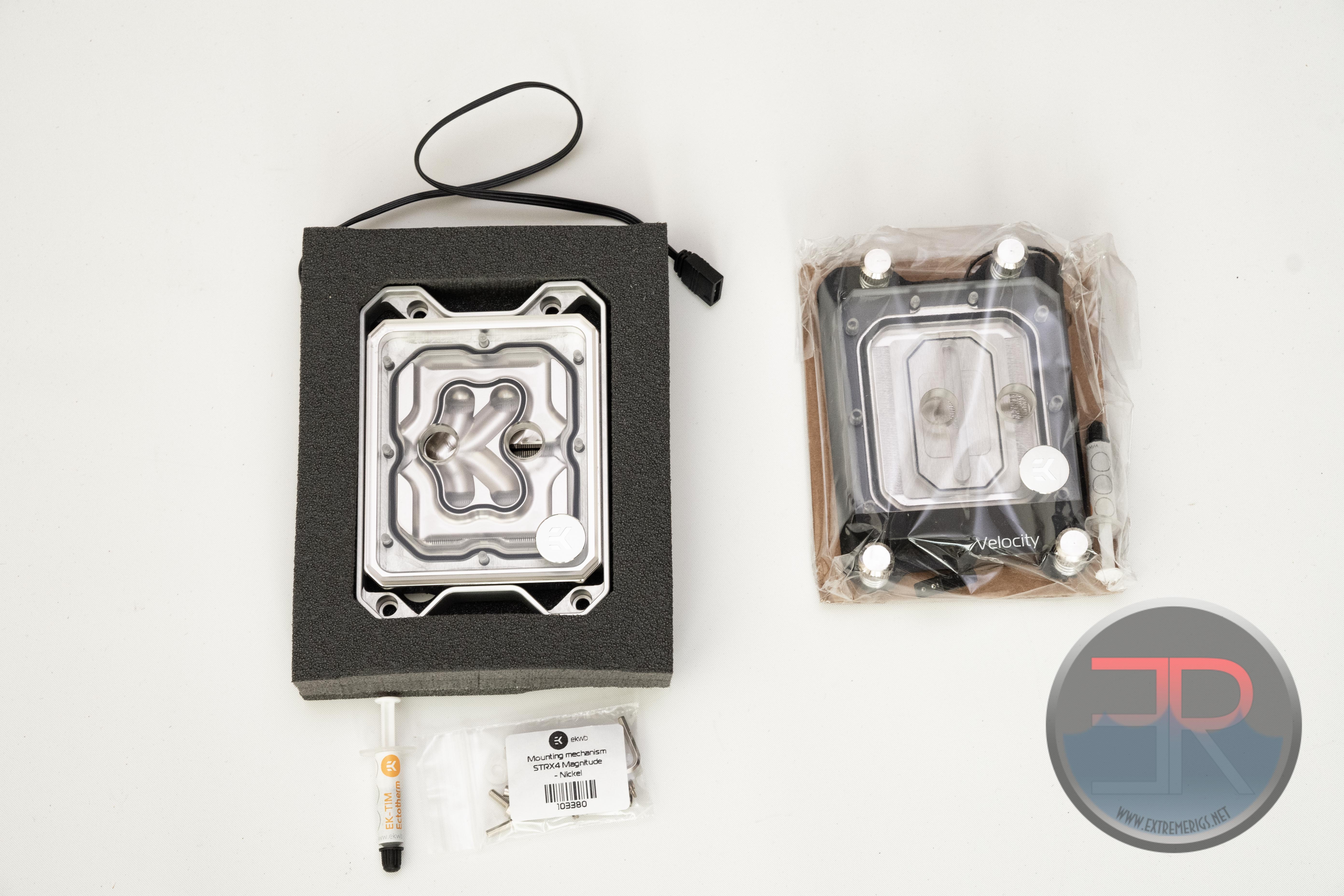
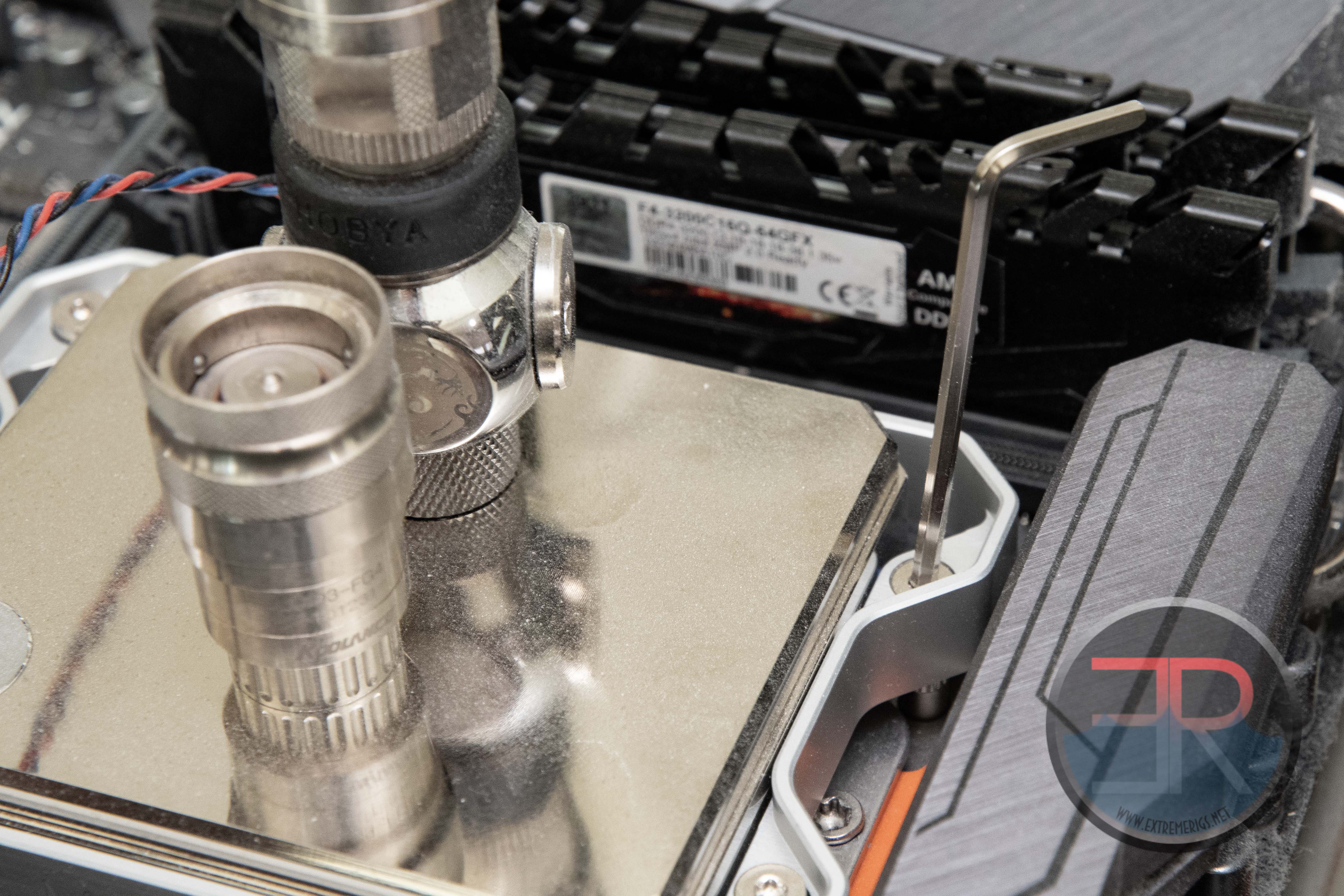
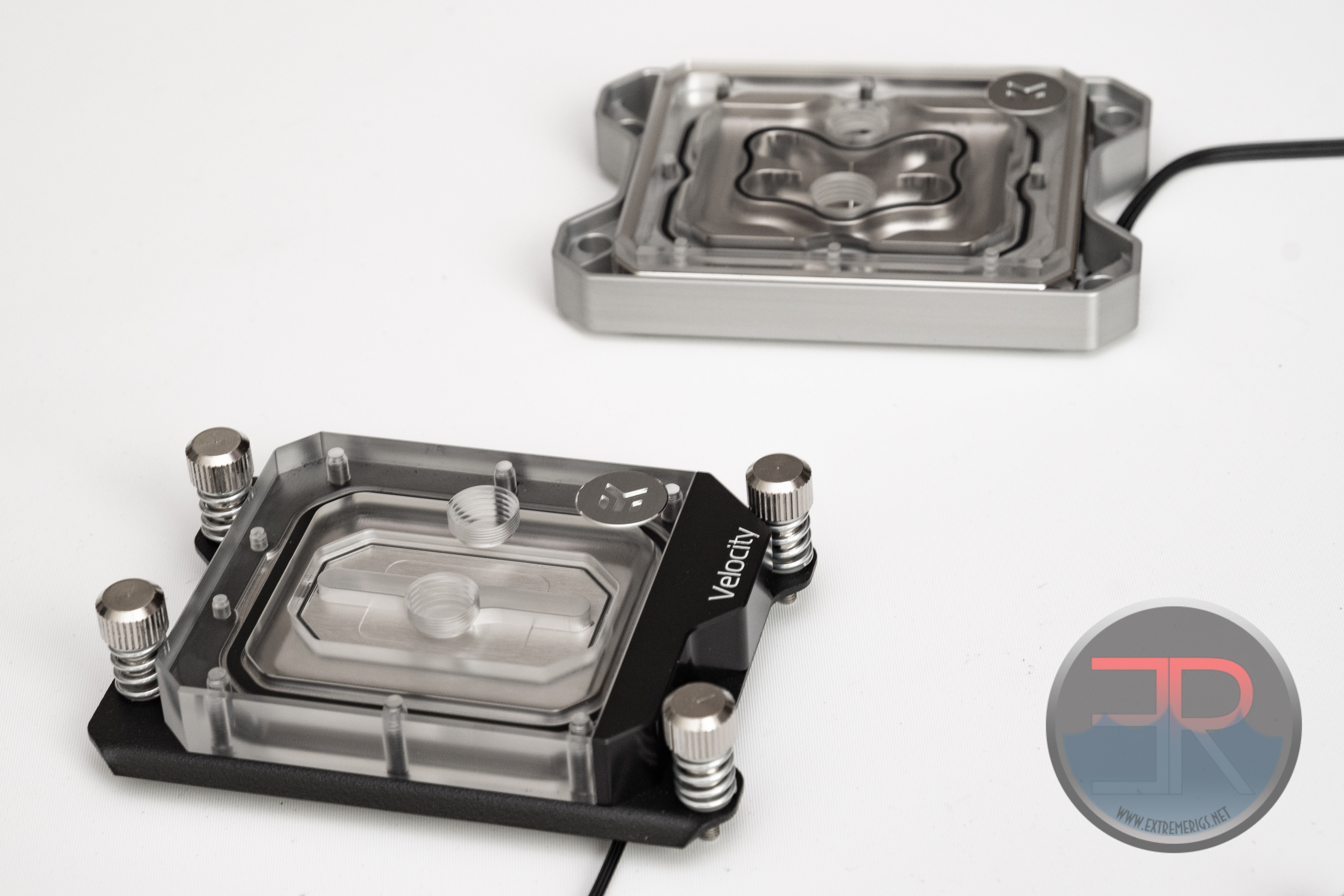
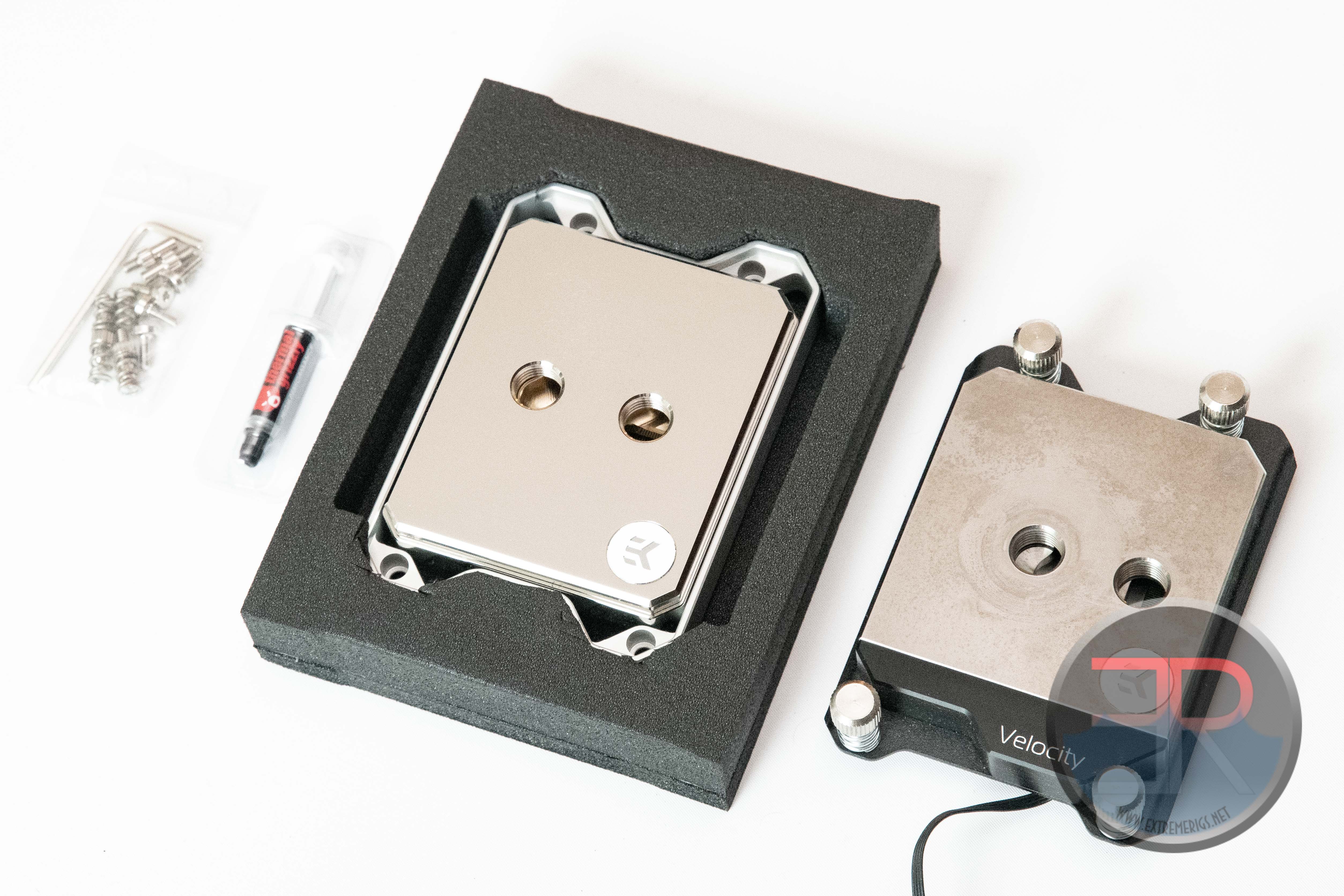
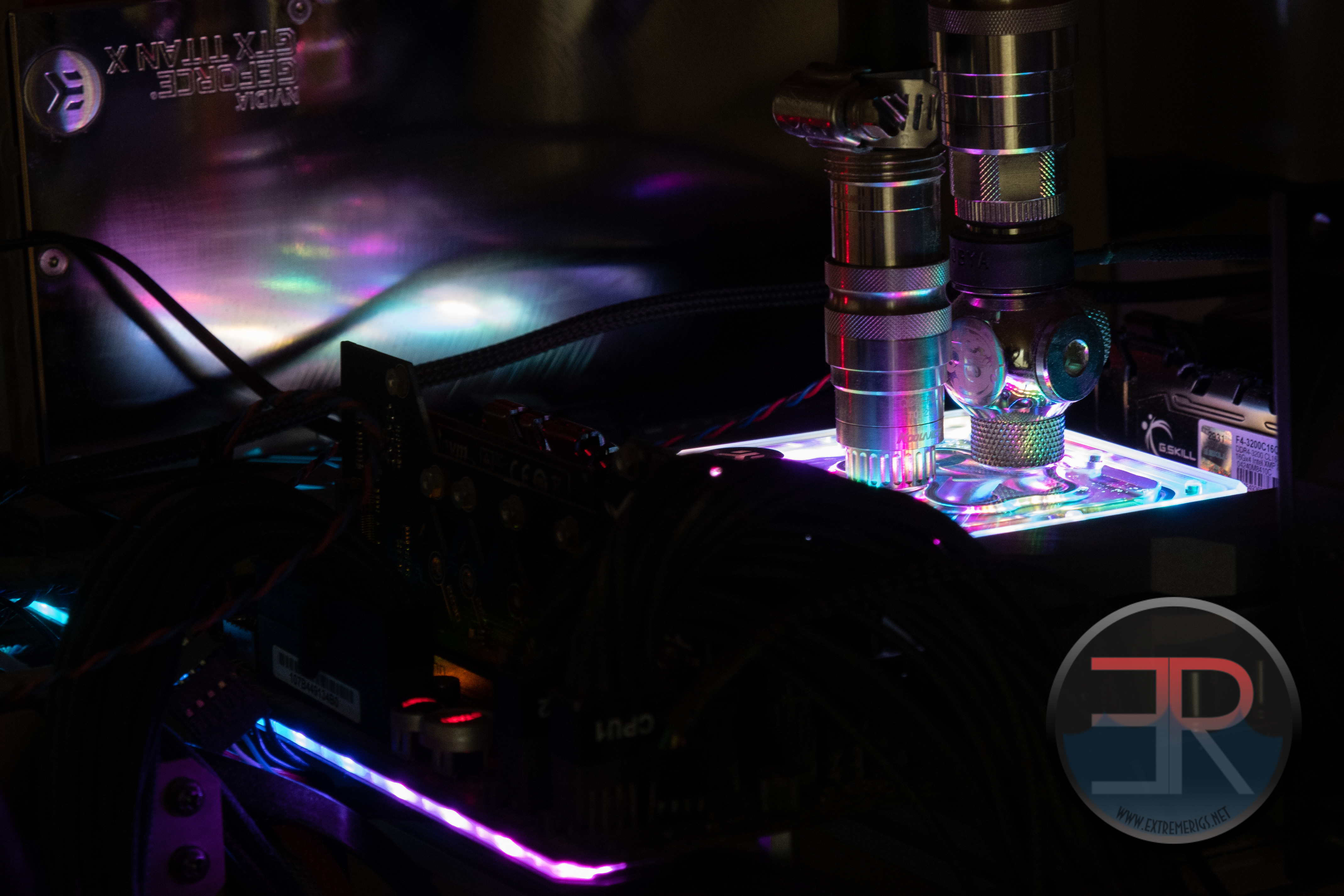
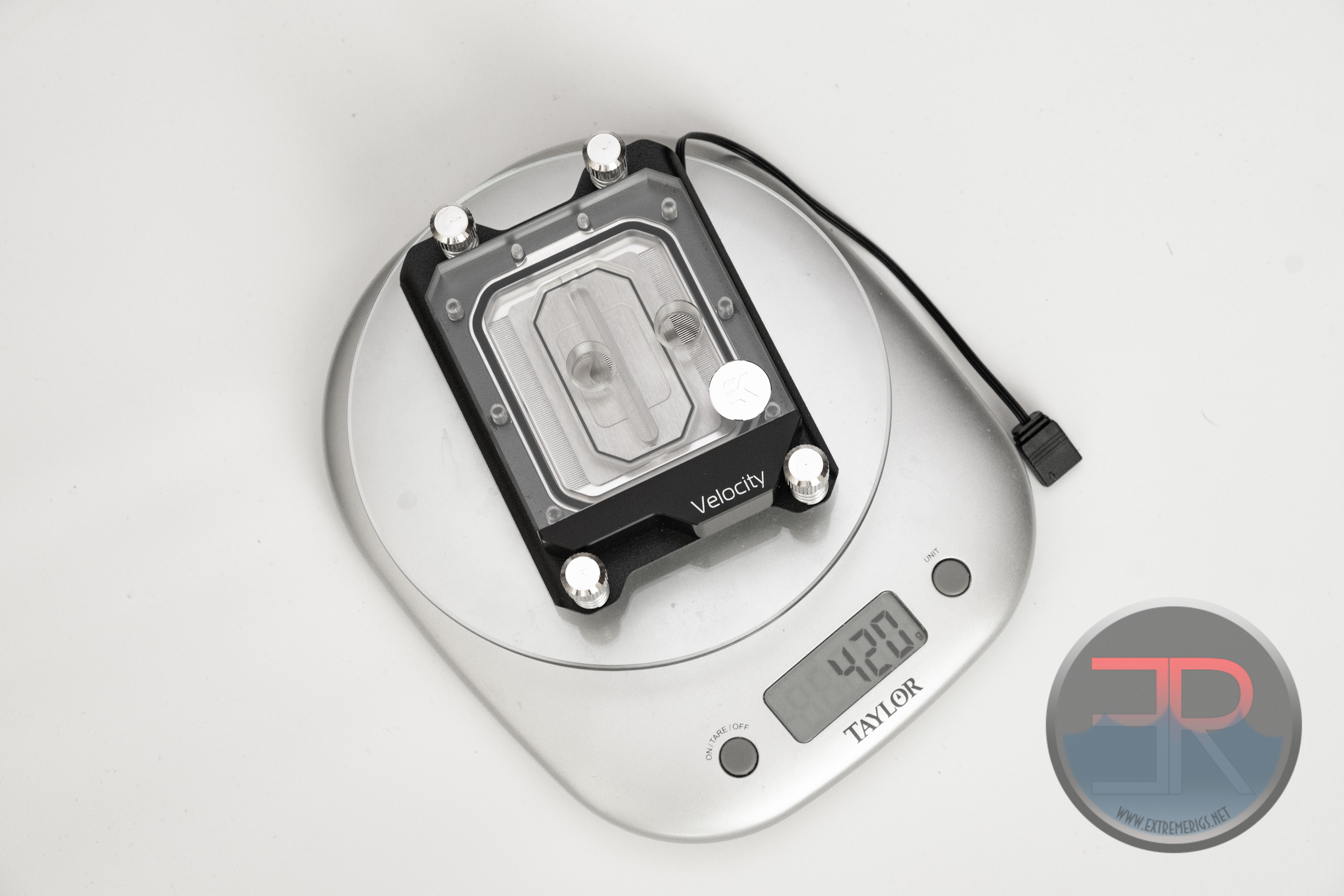
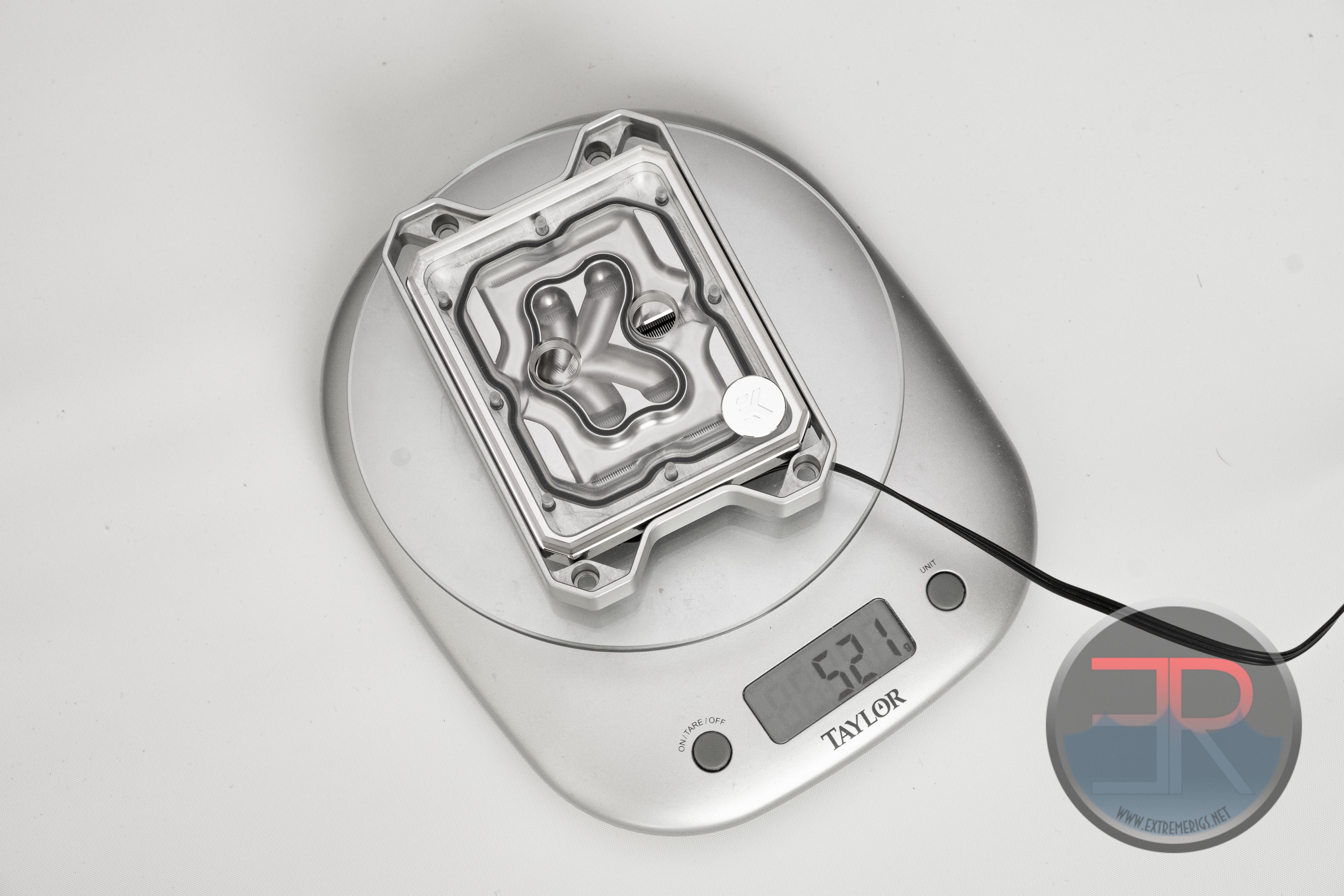
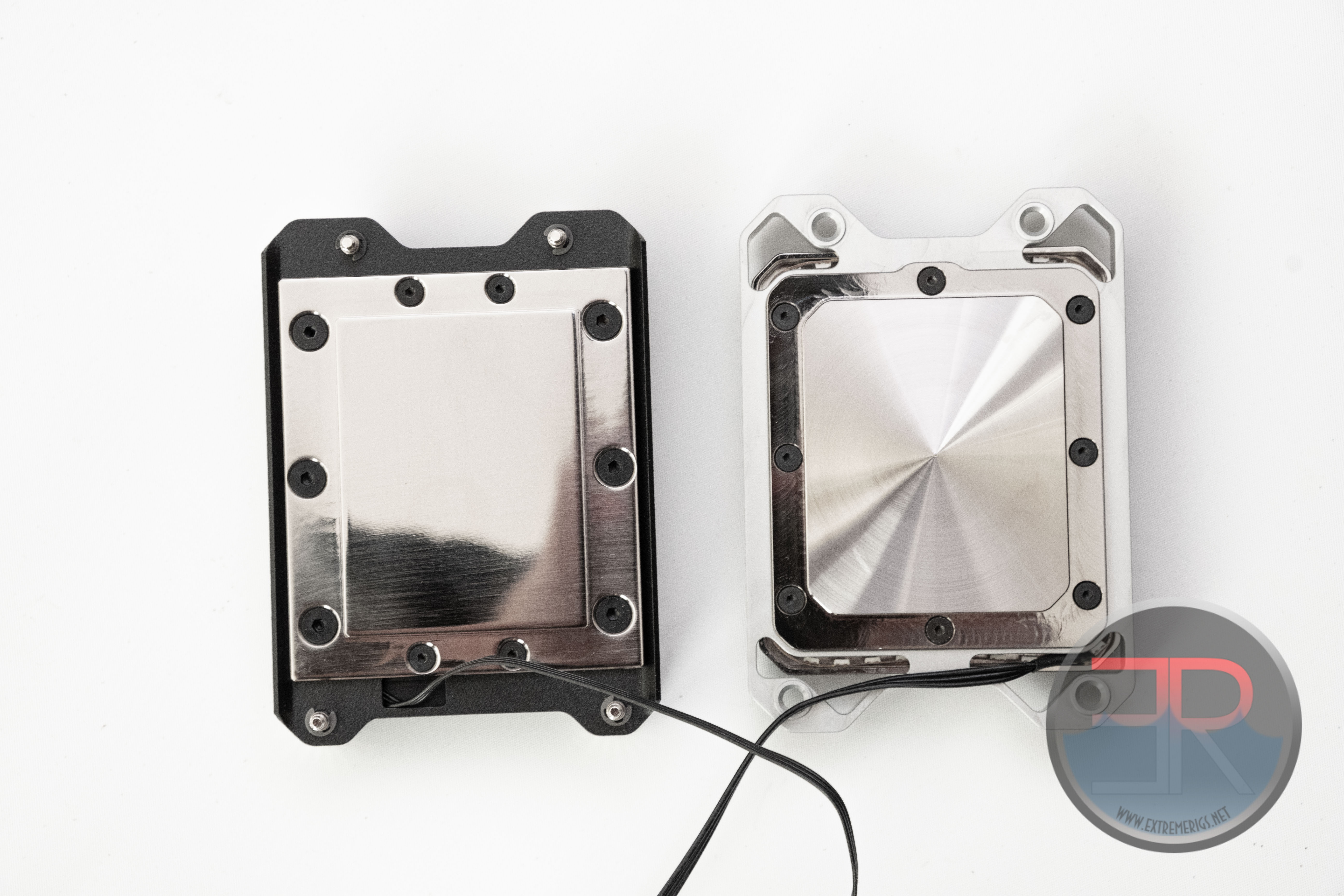
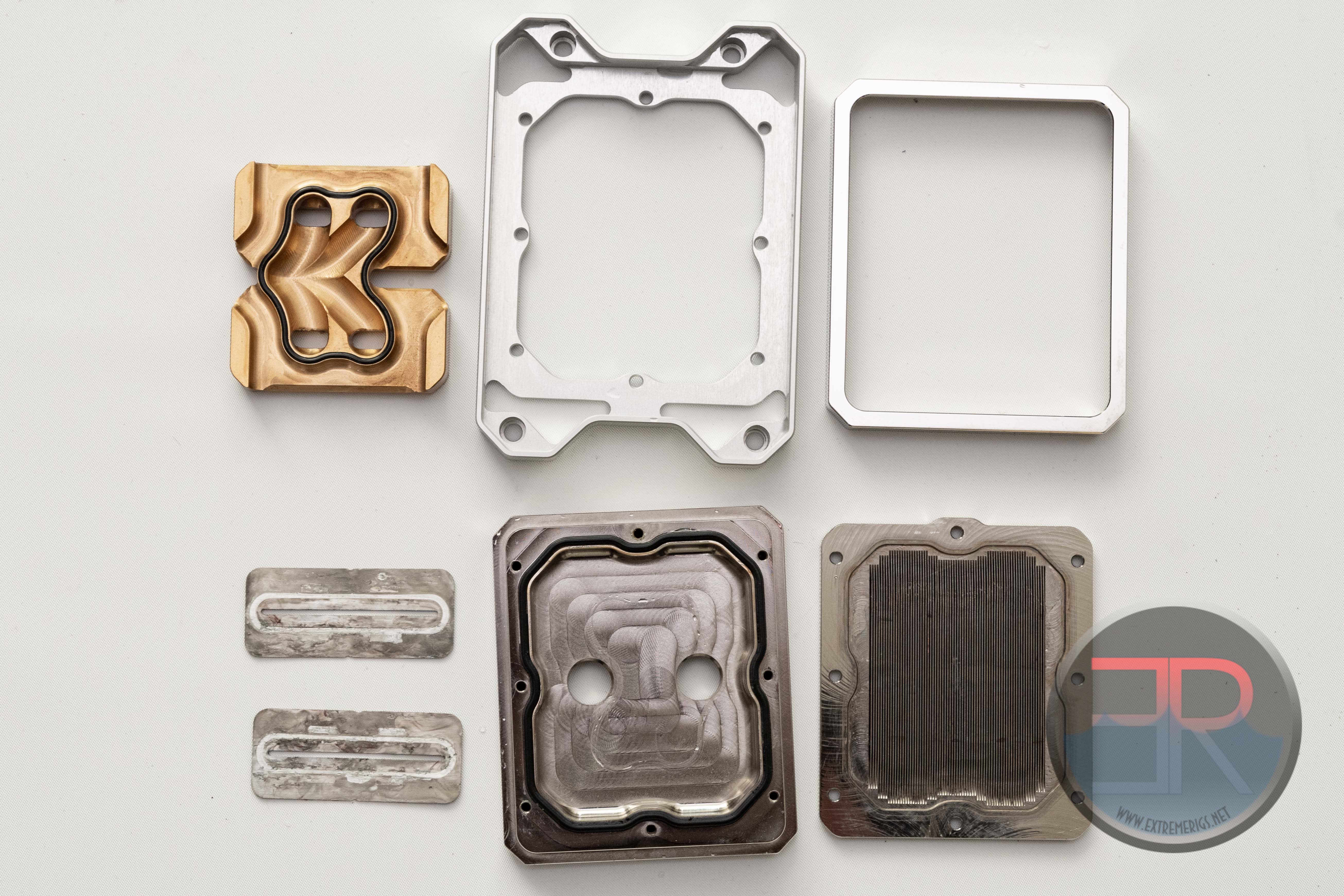
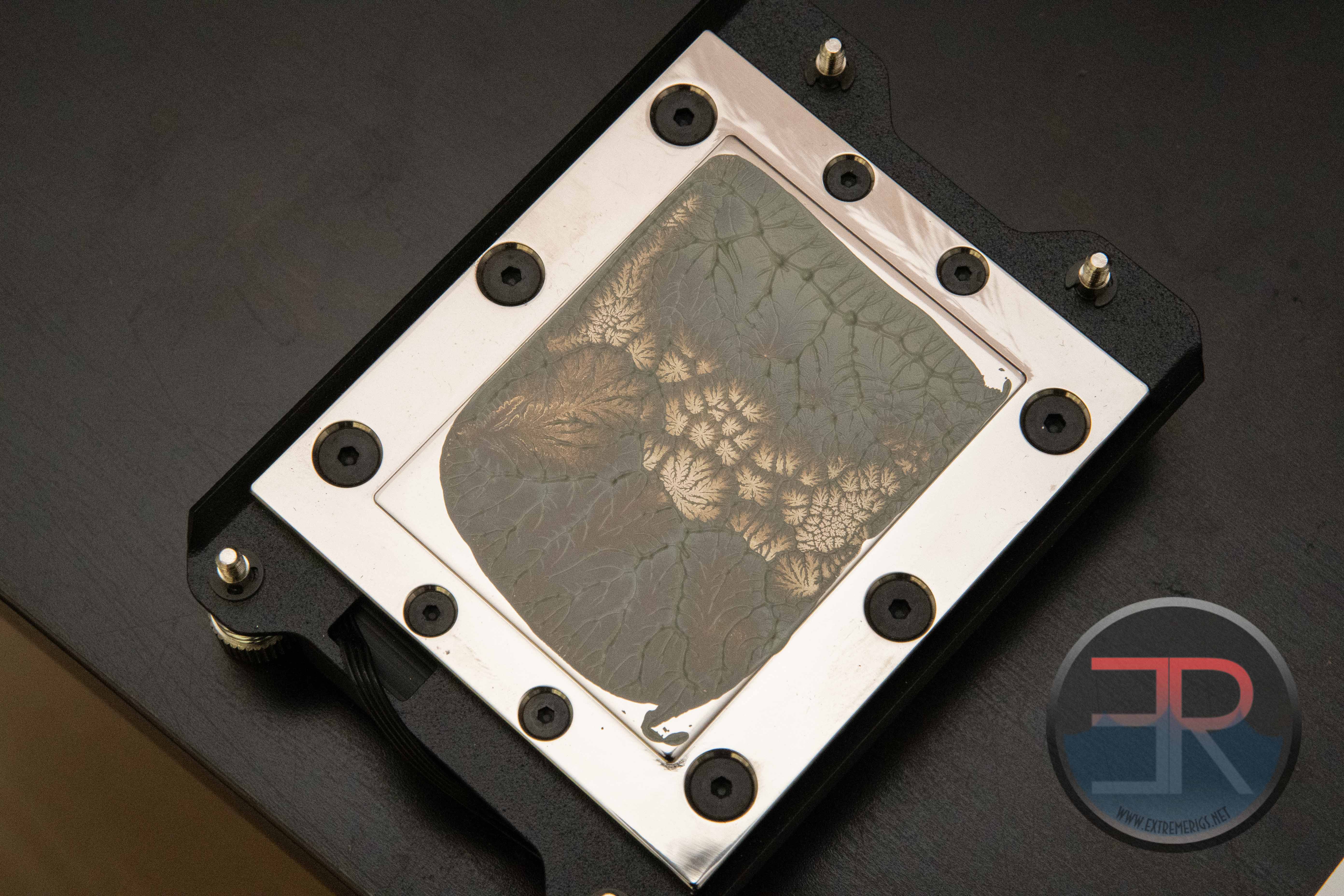
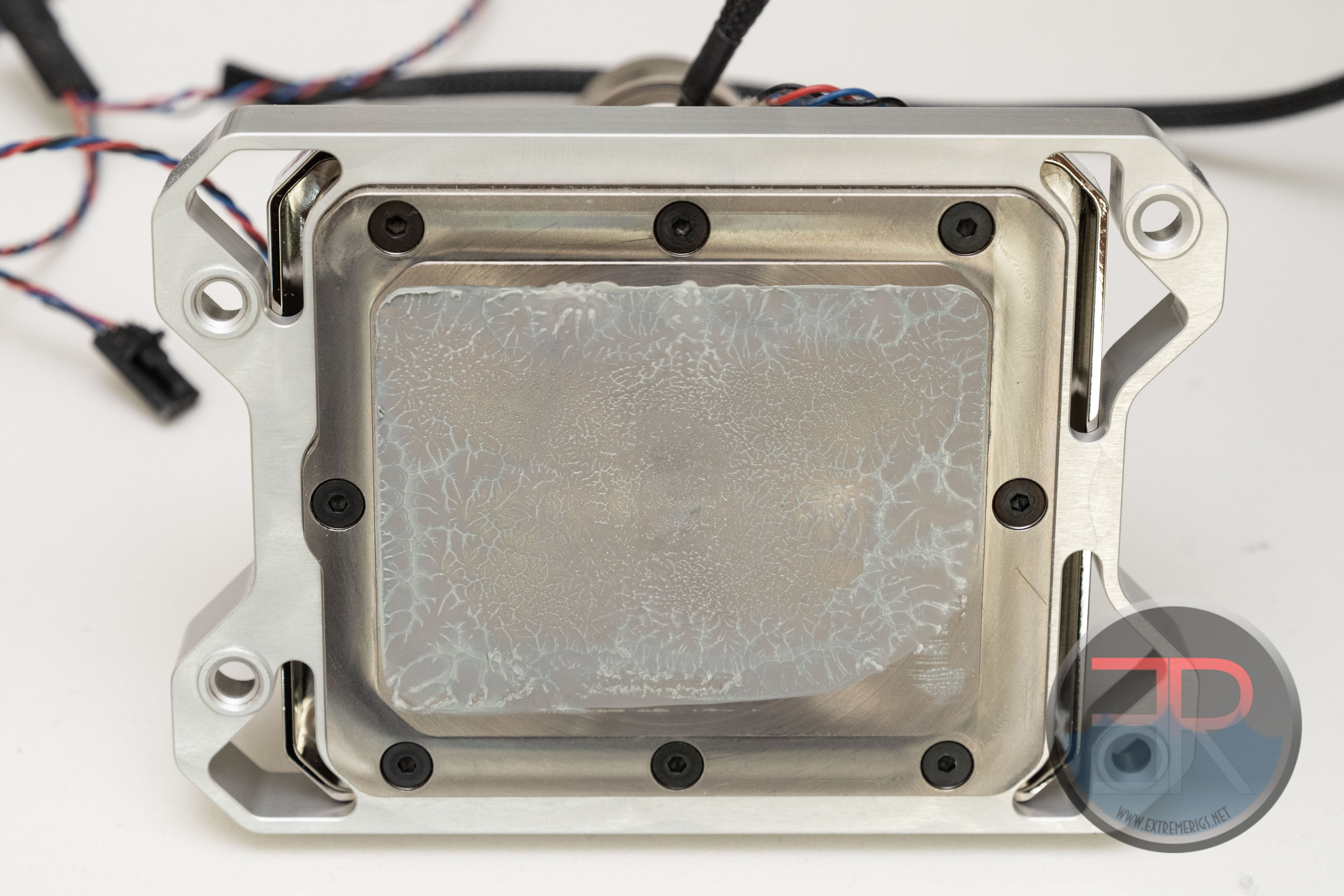
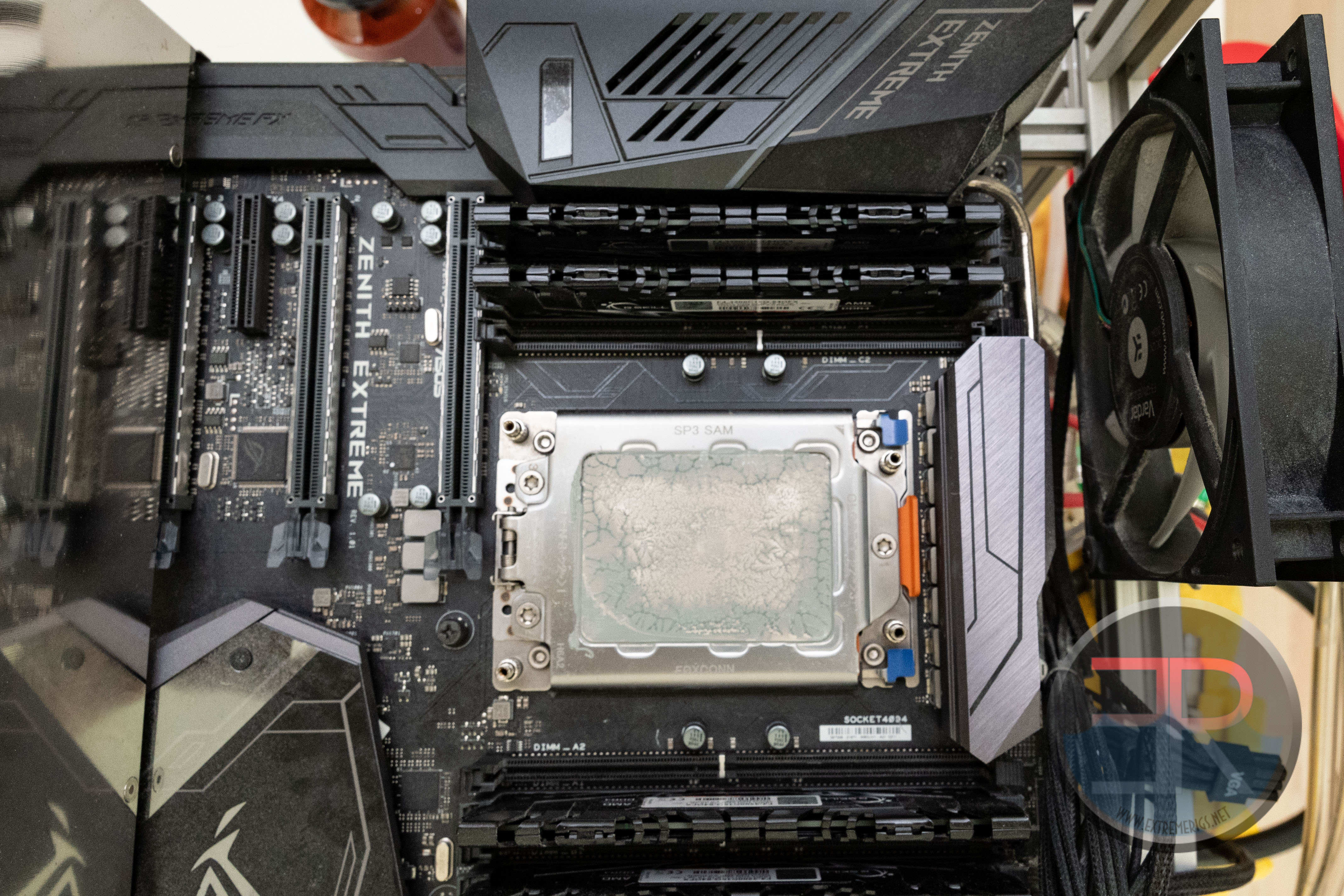
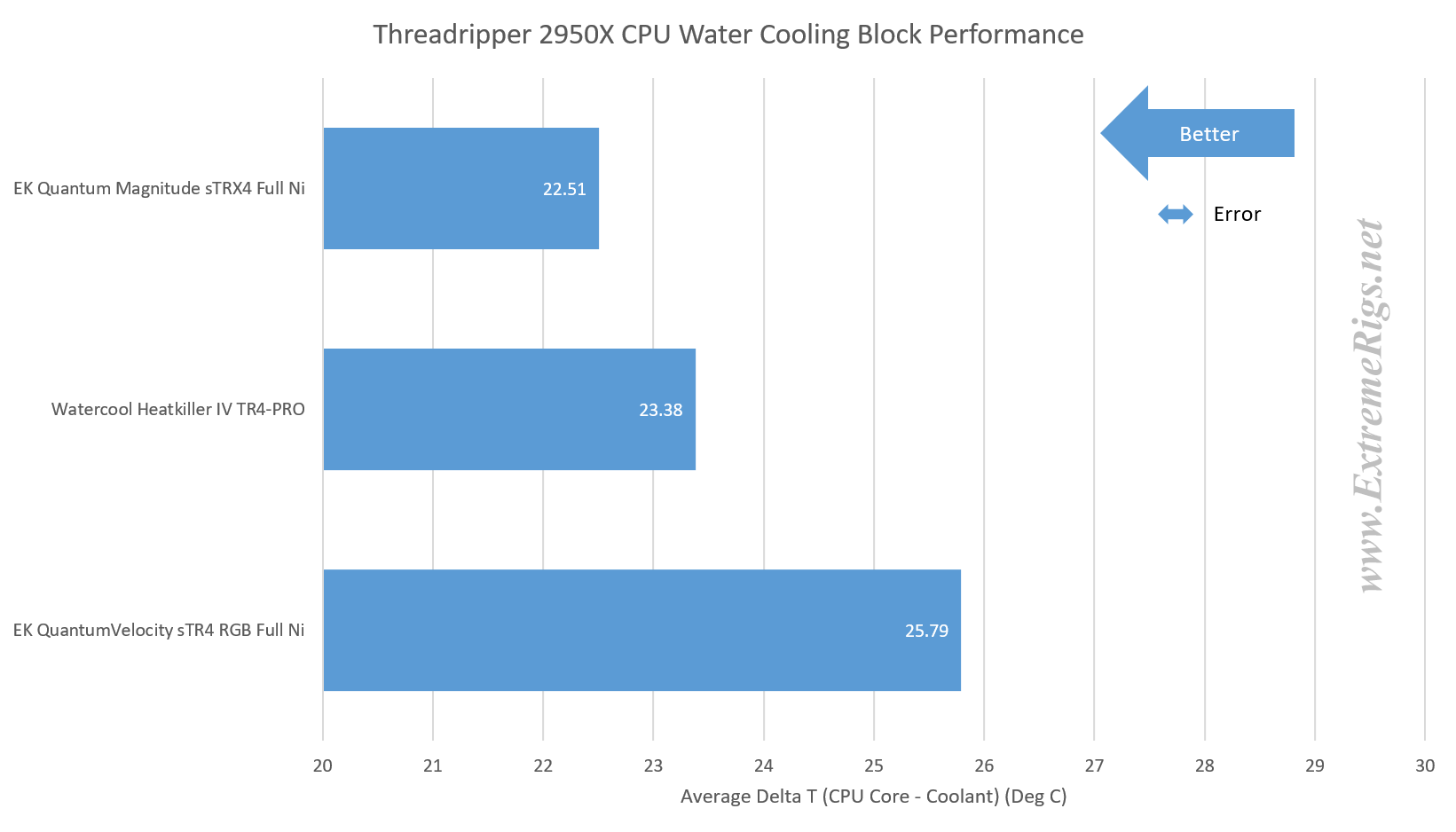
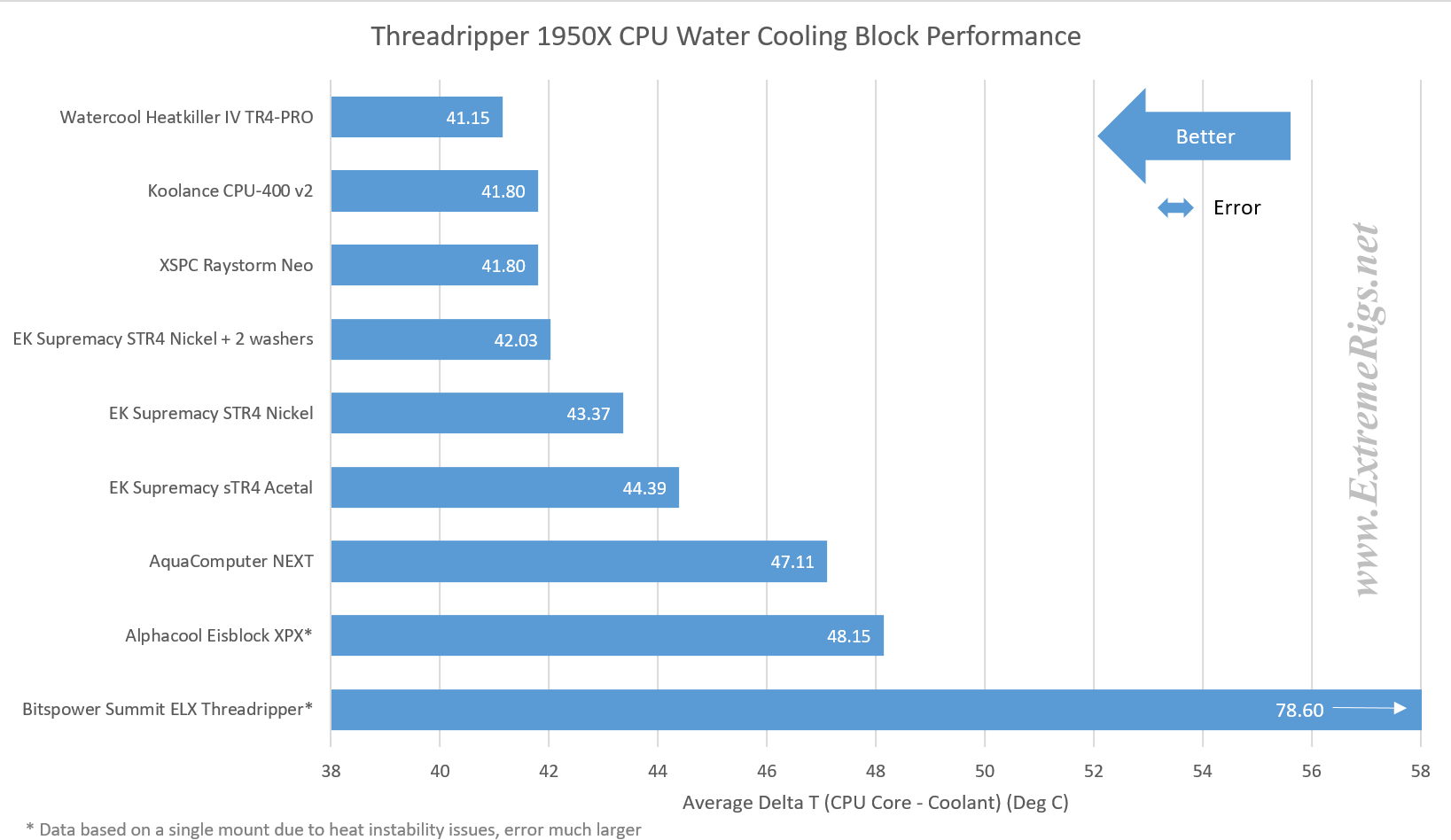
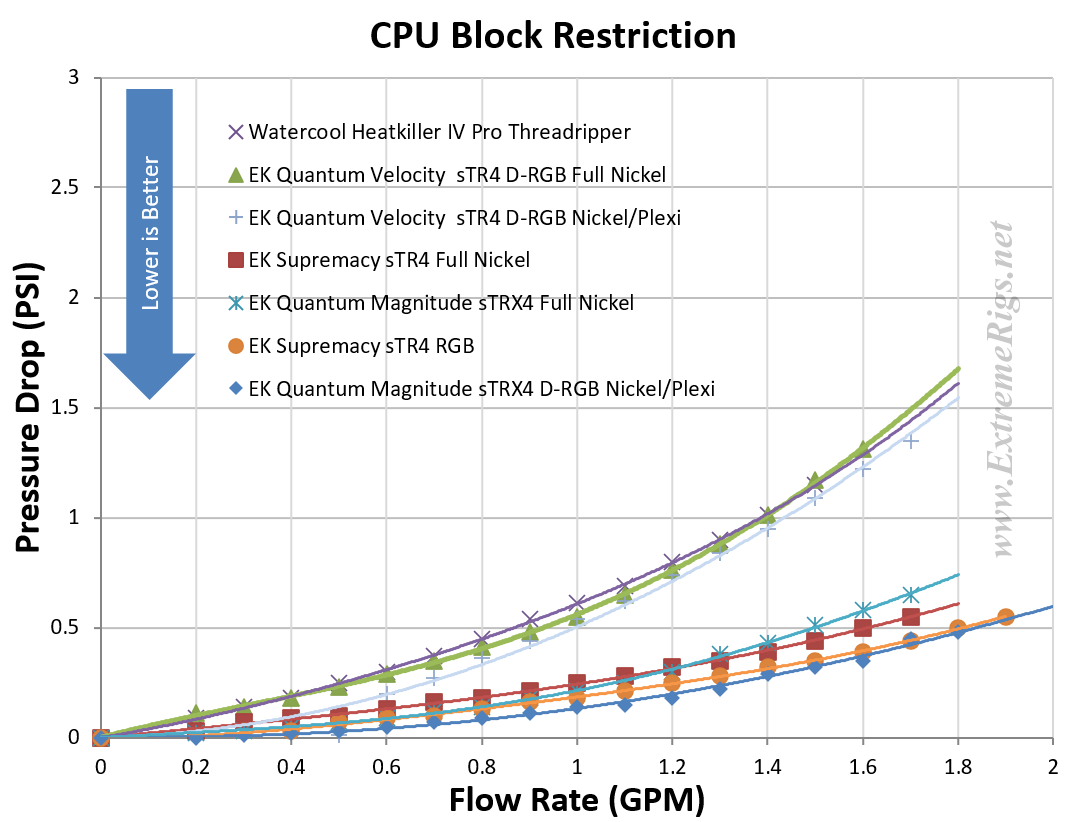
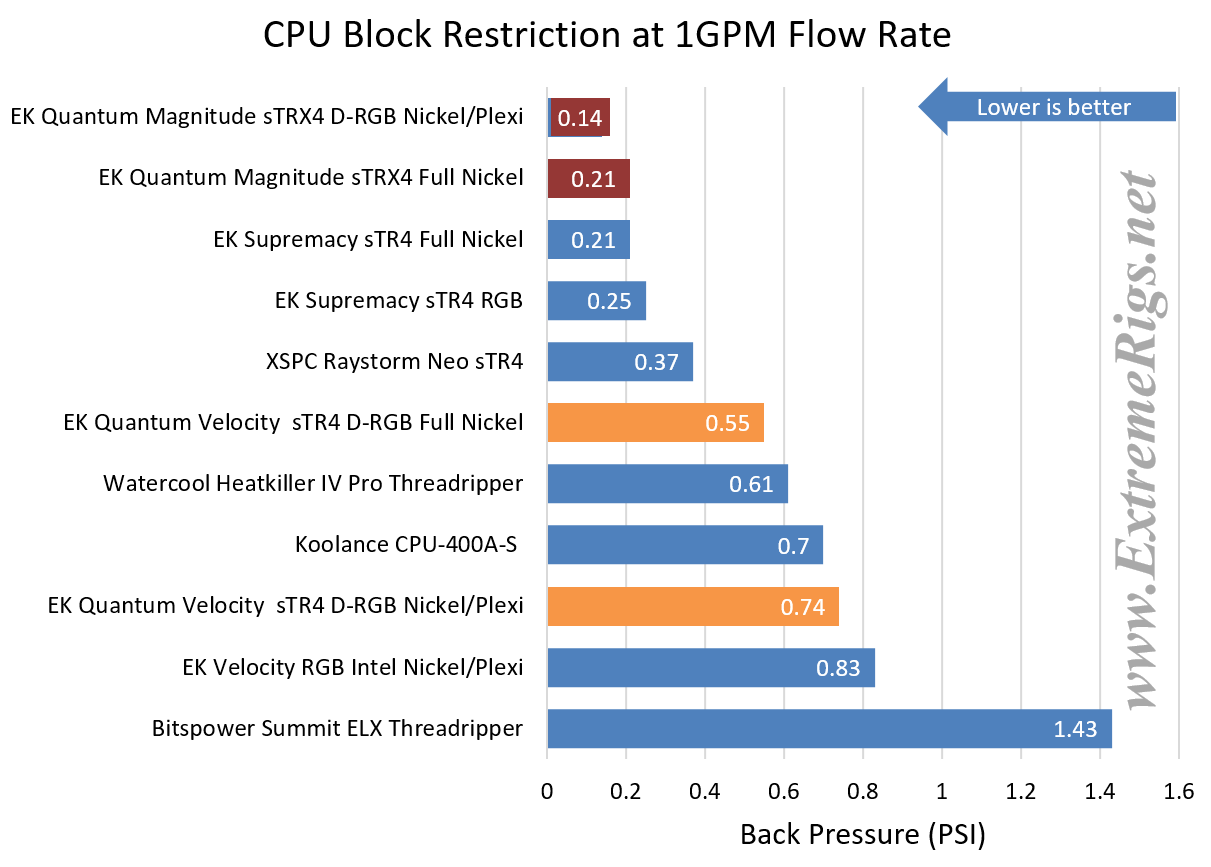



It would be something worth to consider if not the insane price tag. I mean. This thing is literally at the margin of error from heatkiller IV and yet it costs almost 3x of its price. 120€ vs 320€
Seriously? EK lost their minds with these pricing.
Comments are closed.